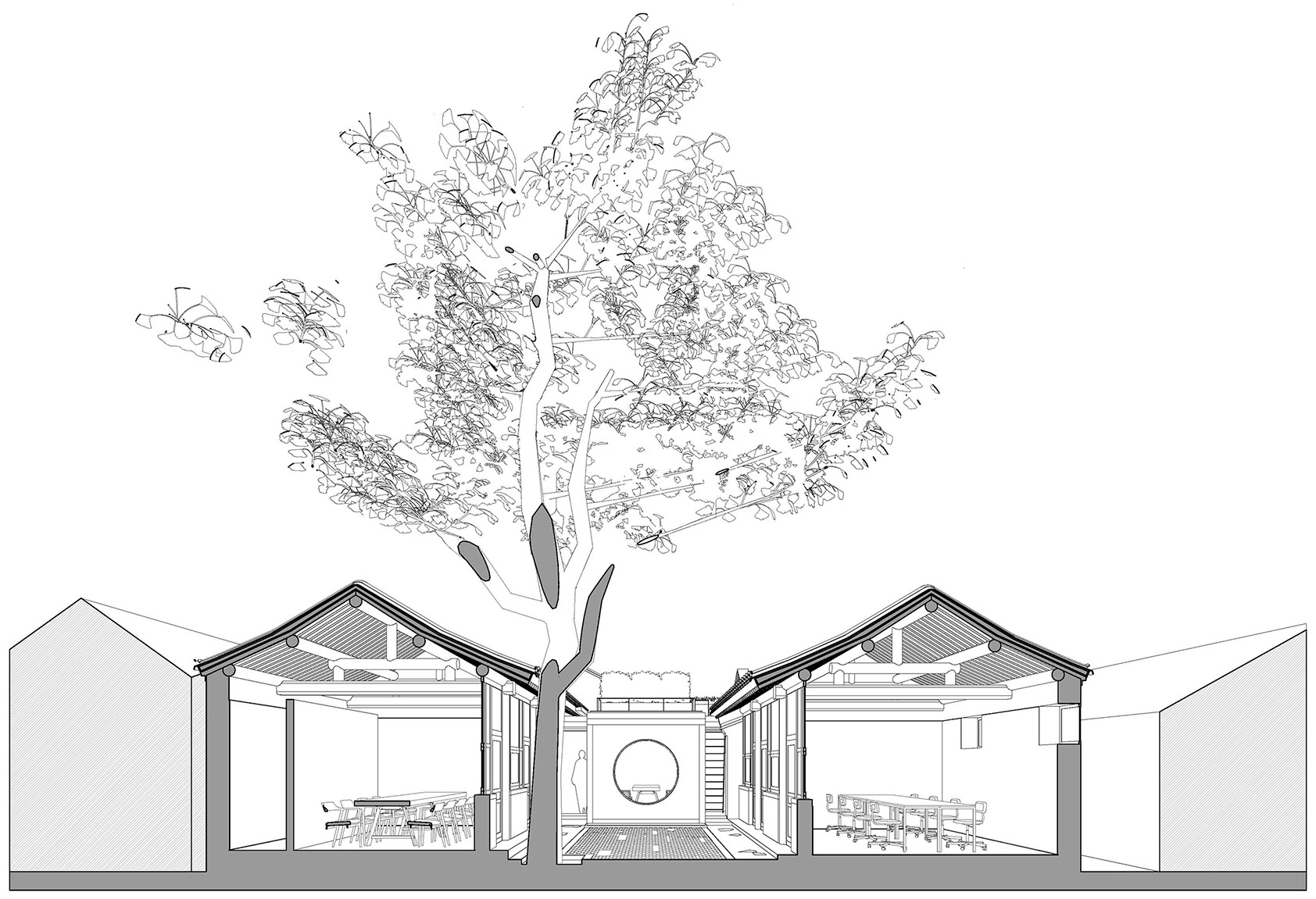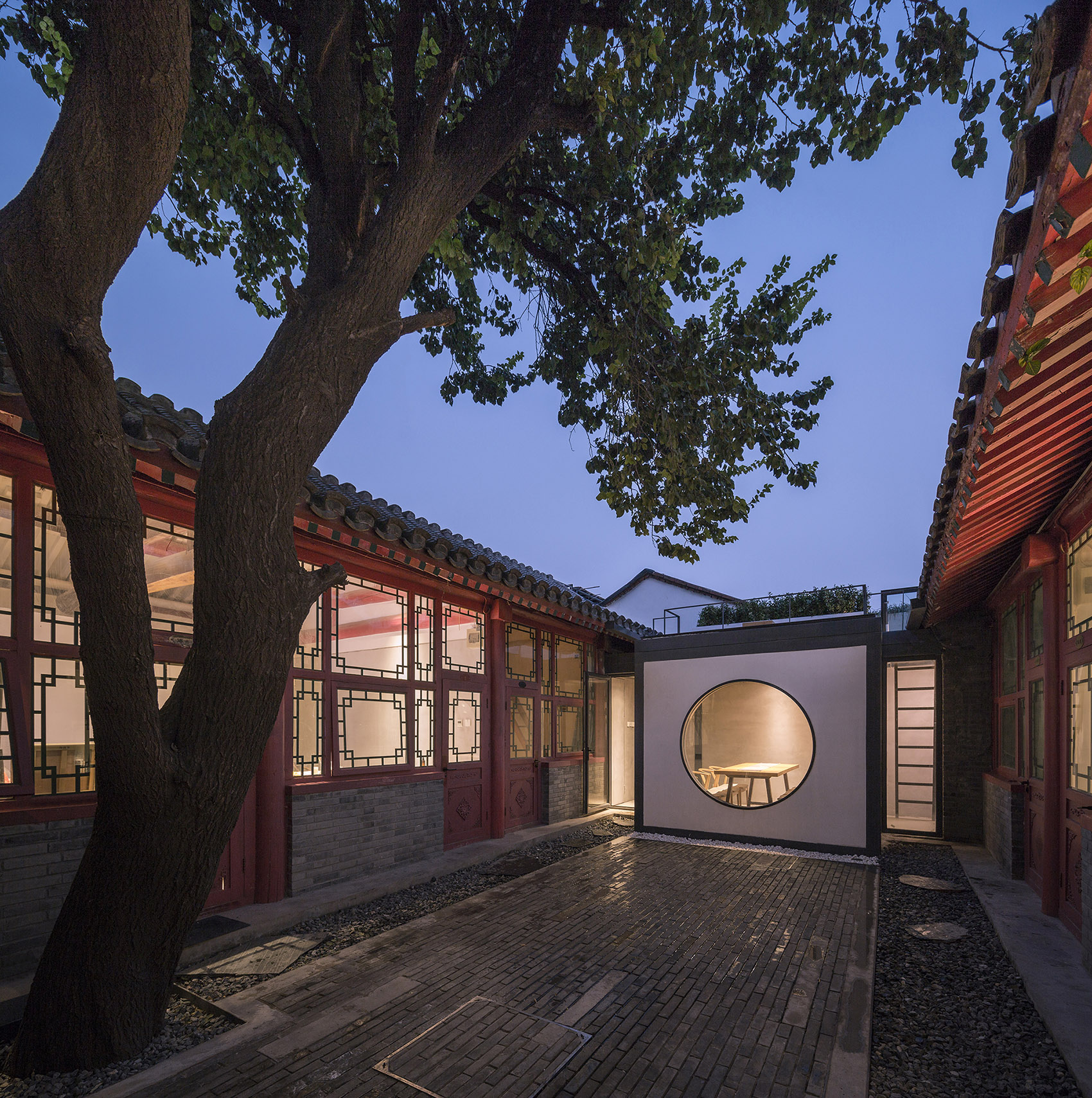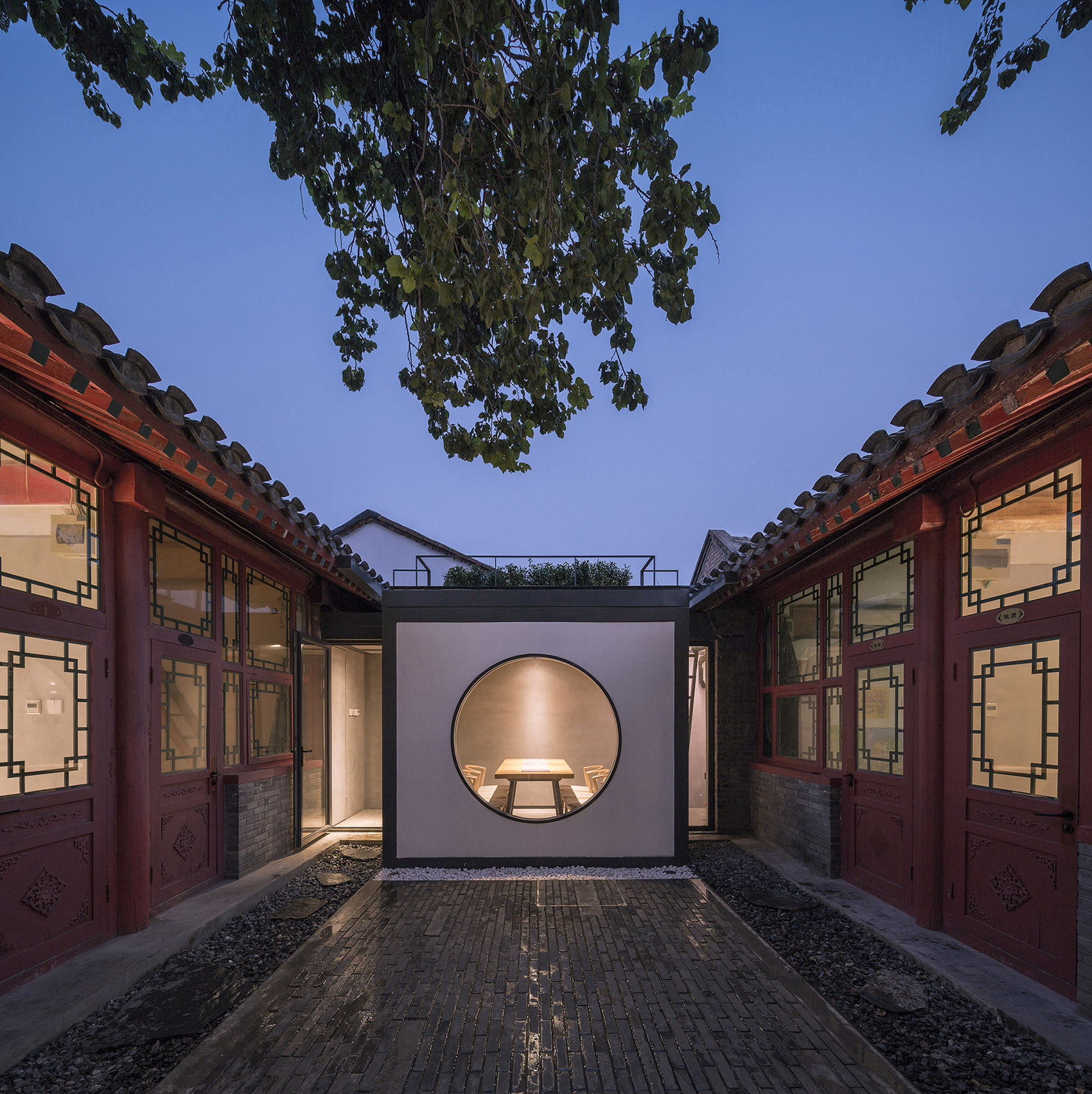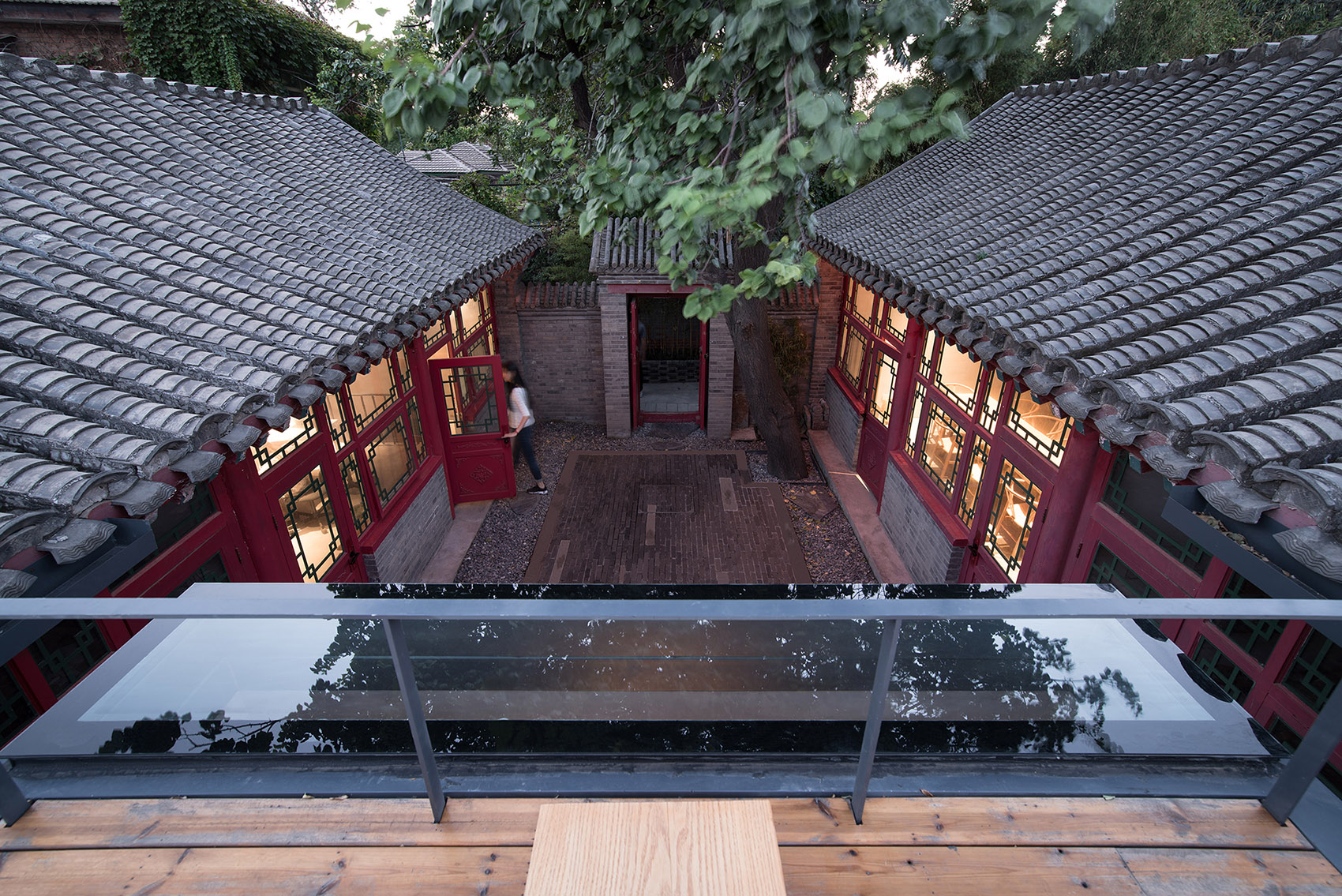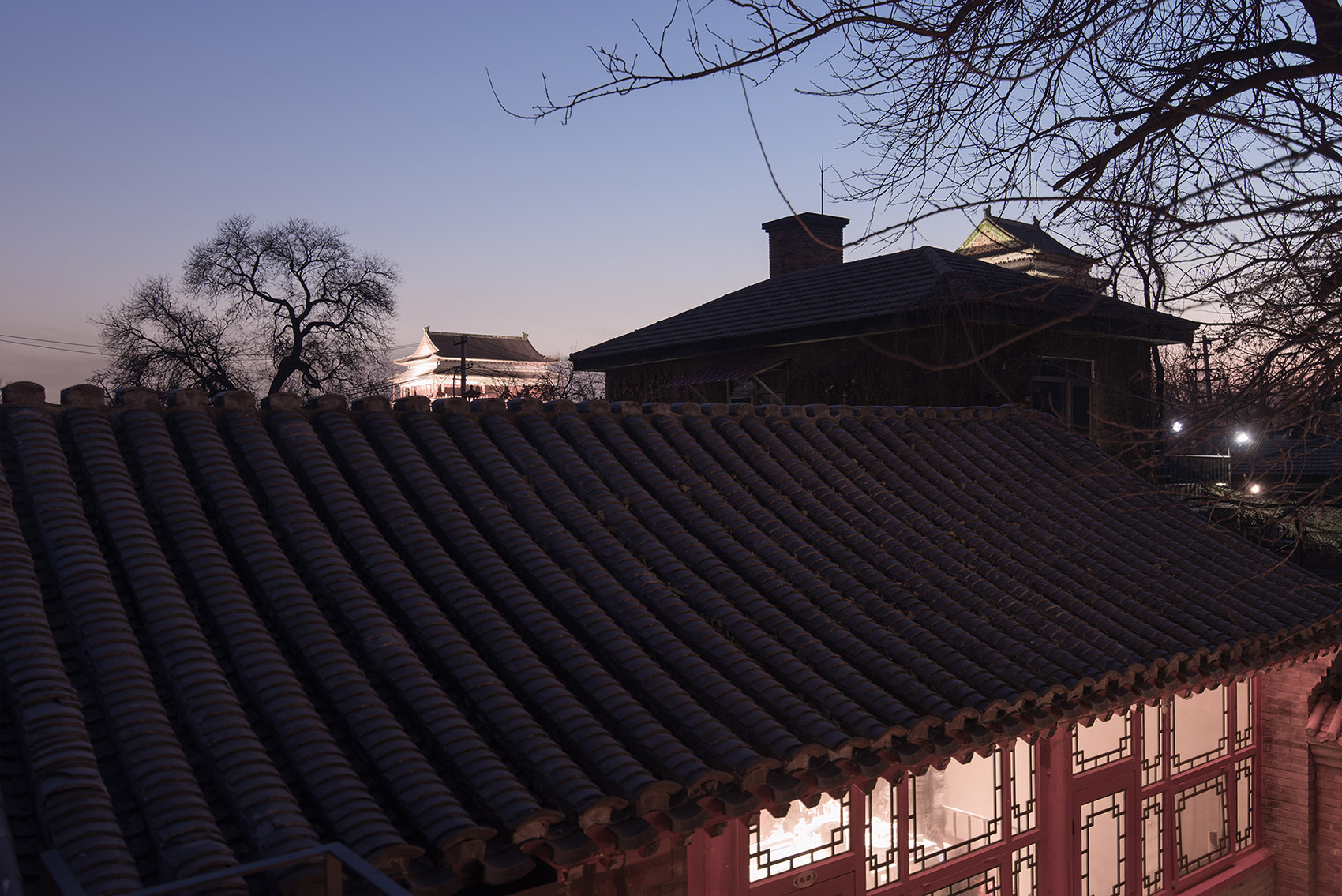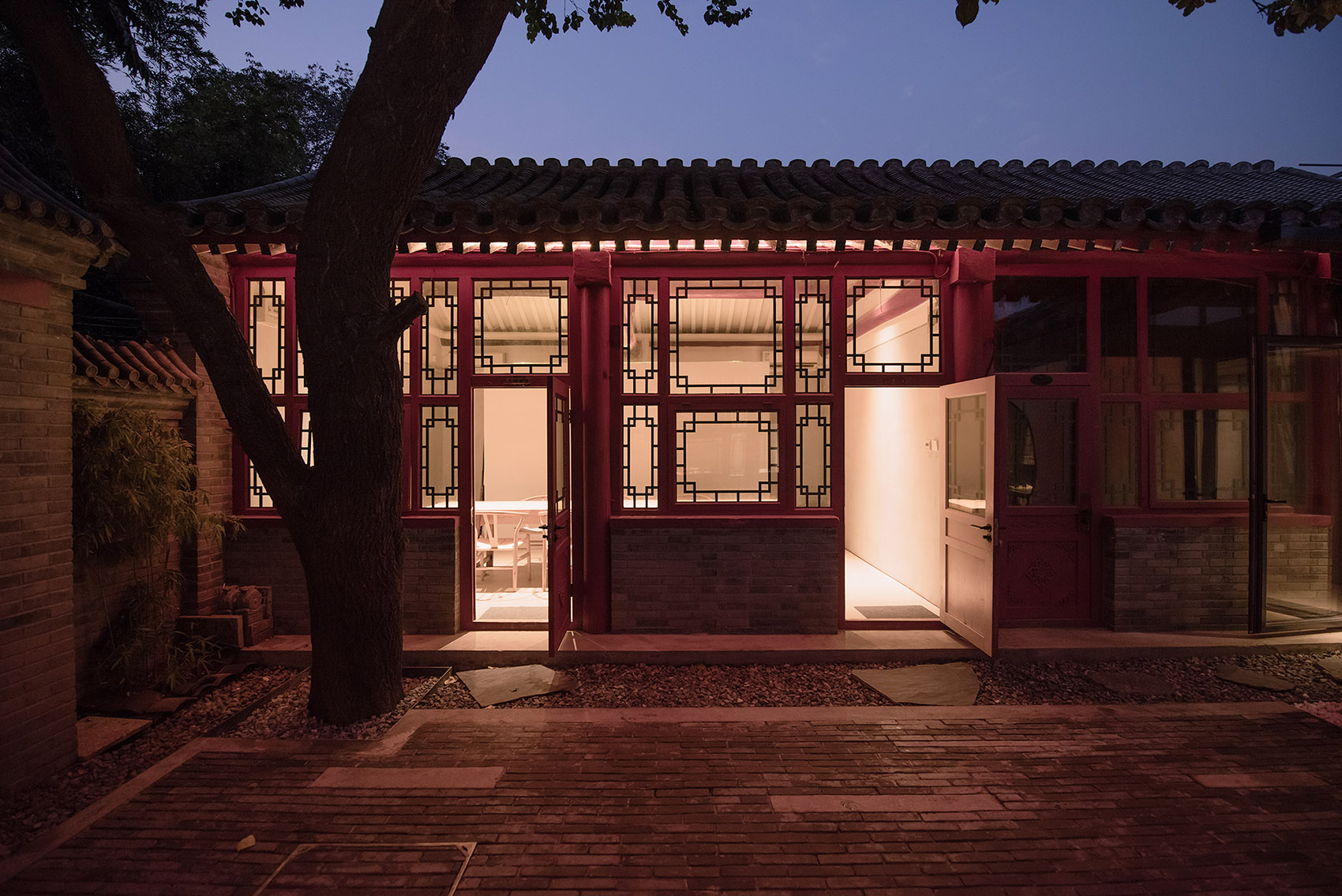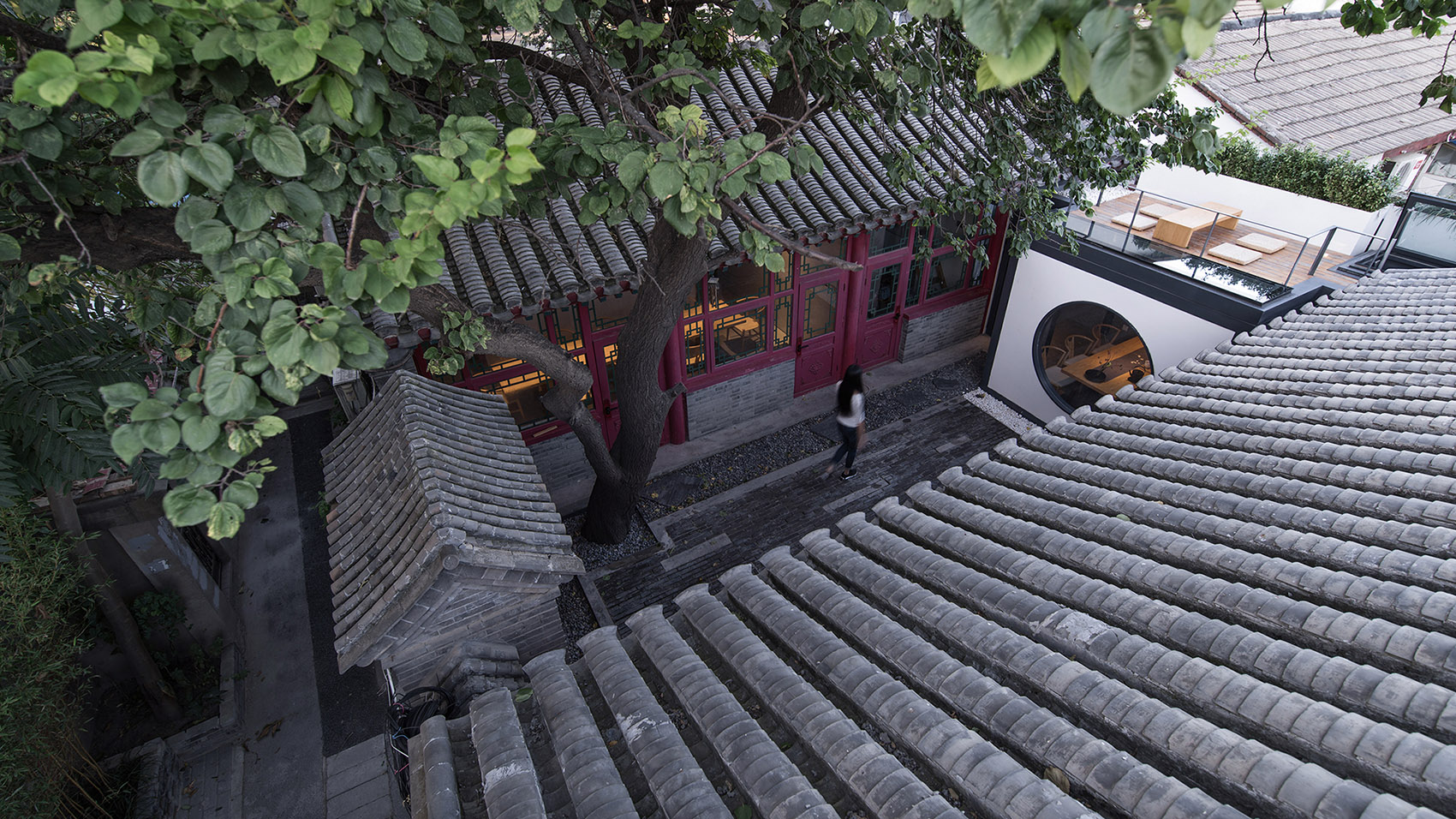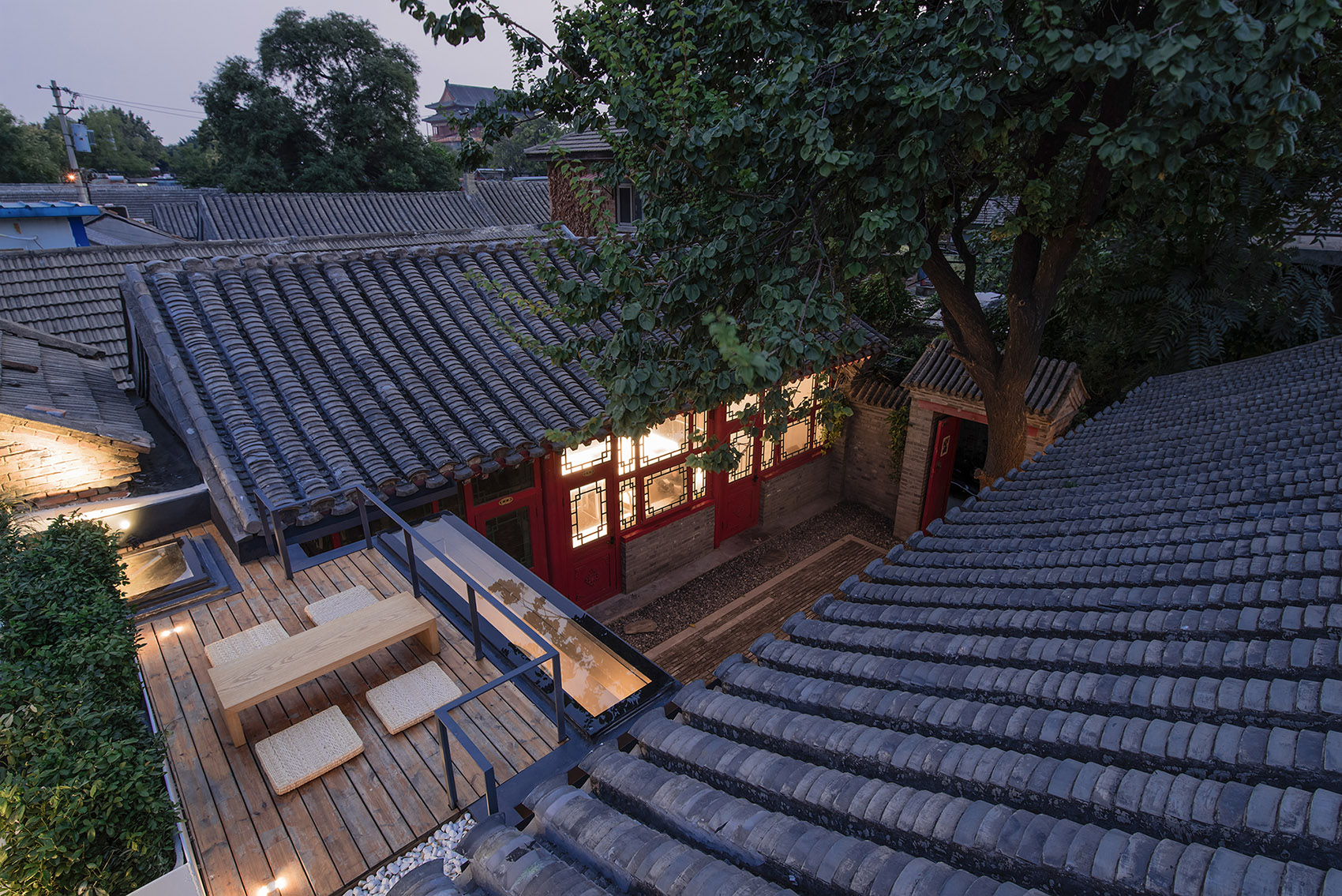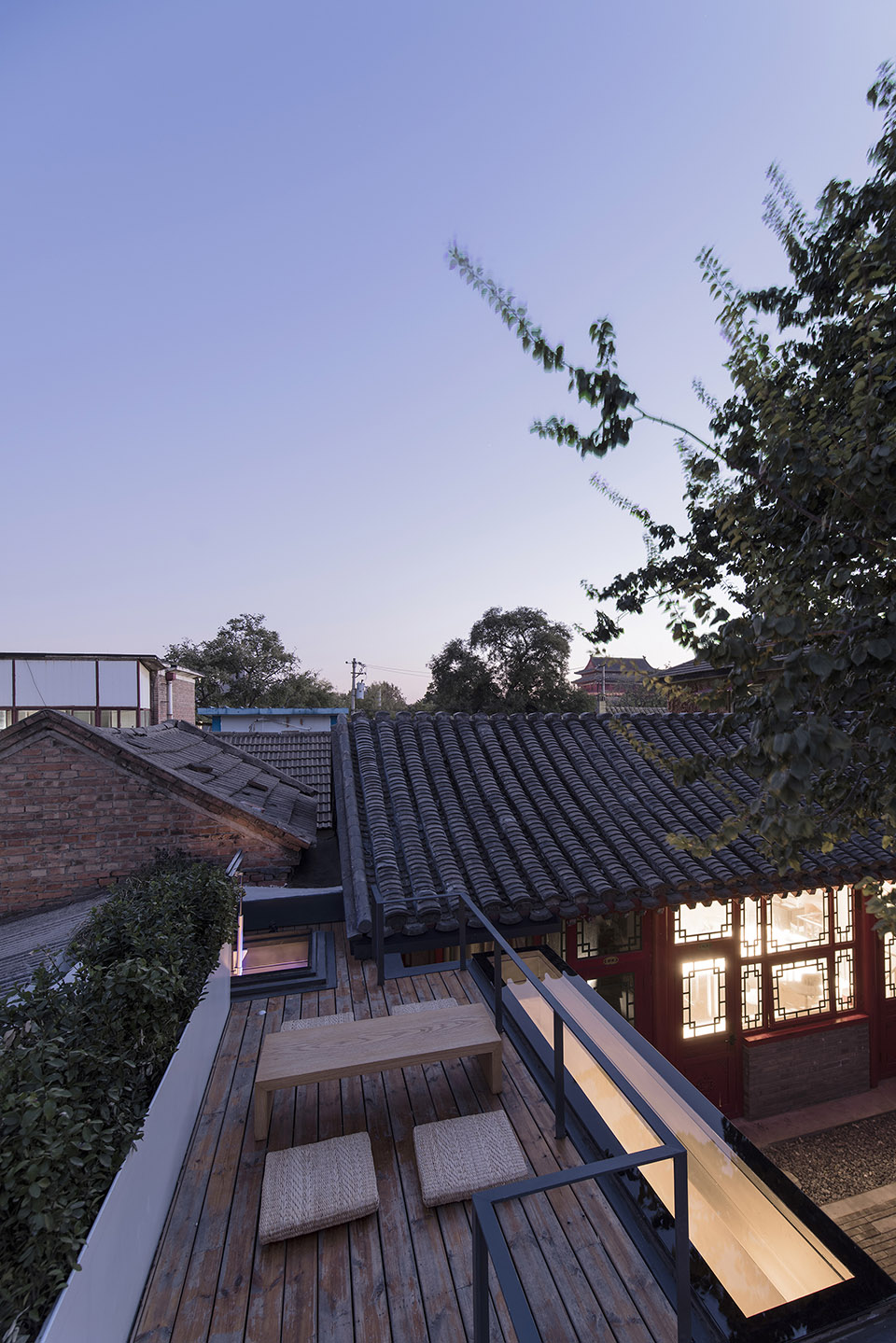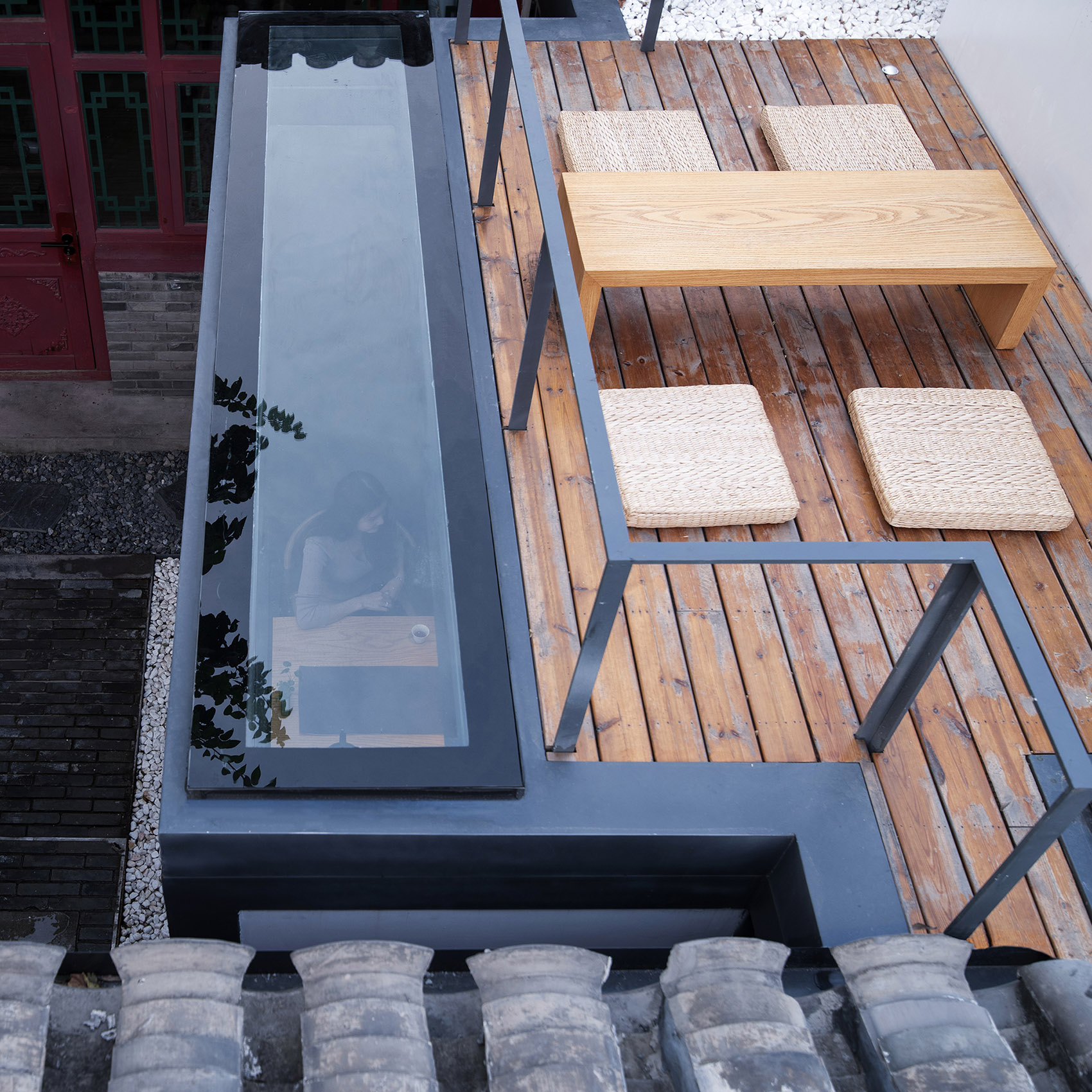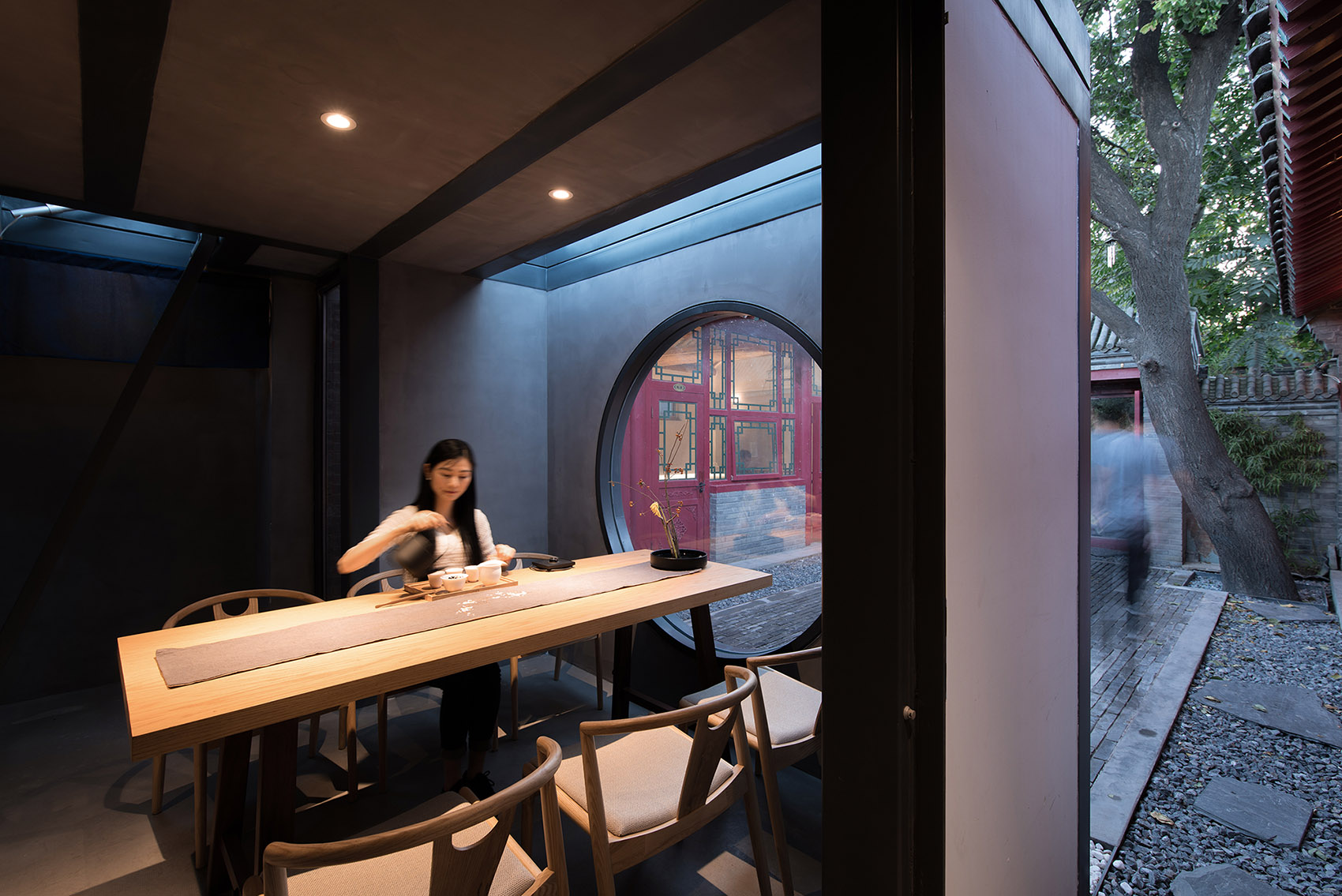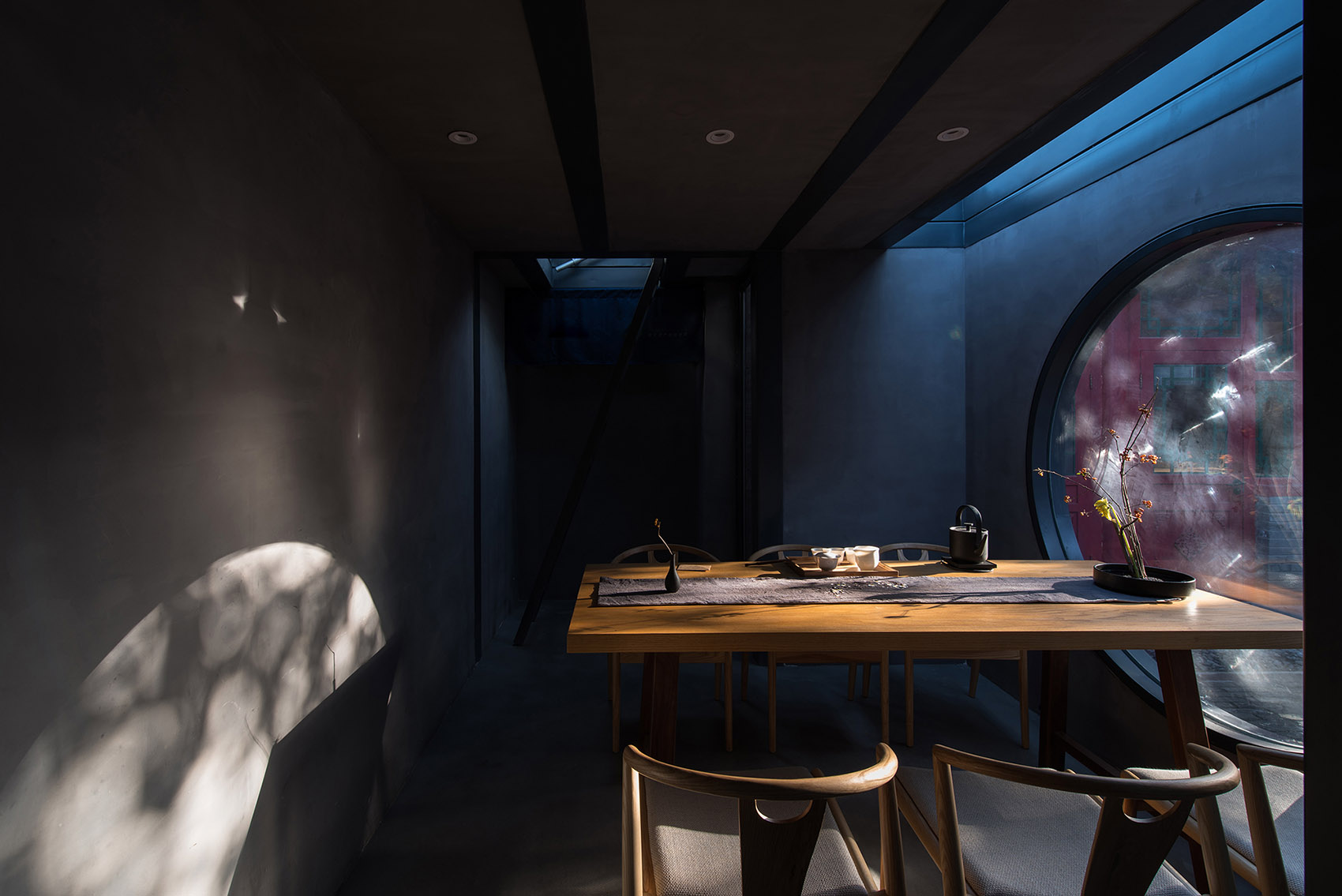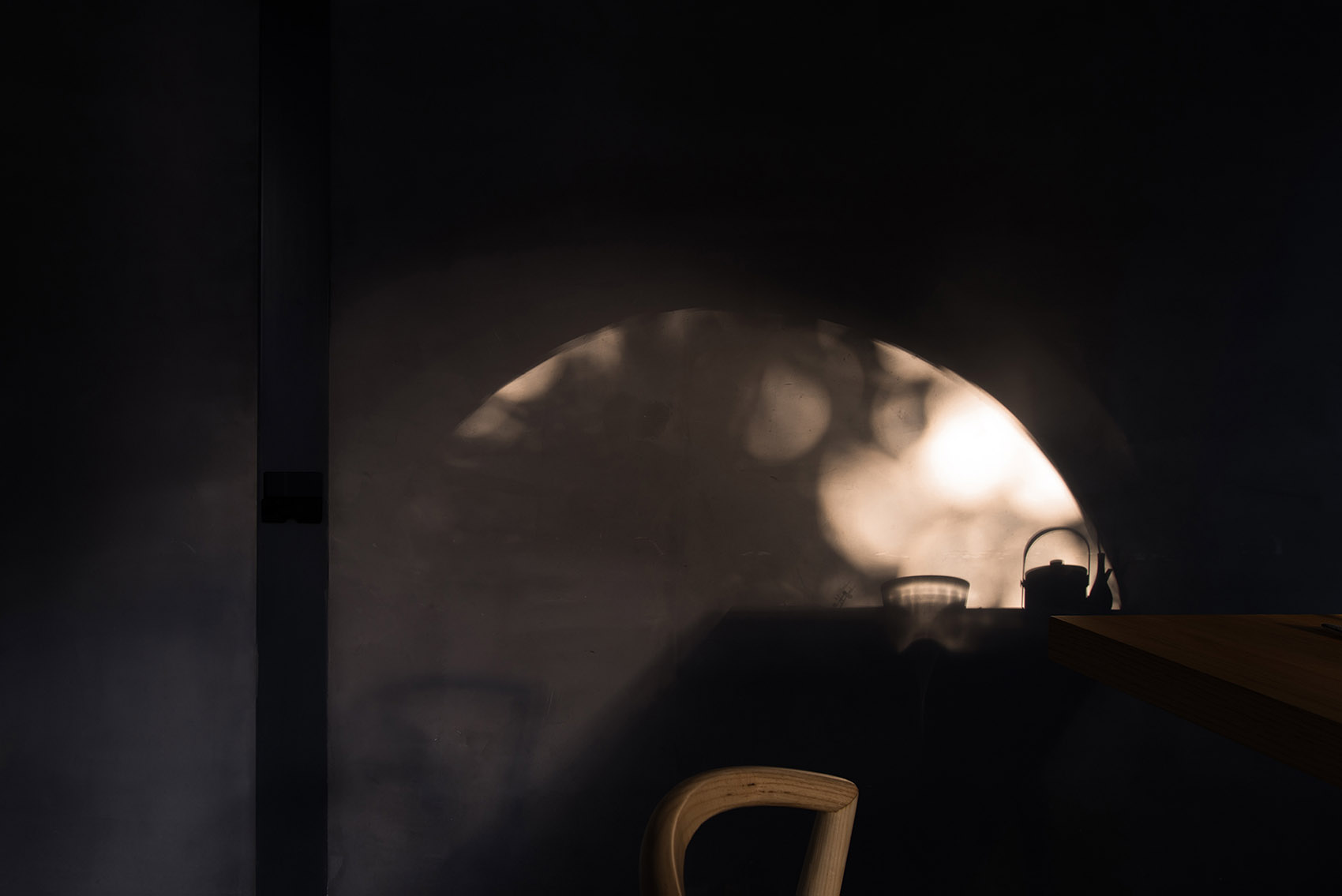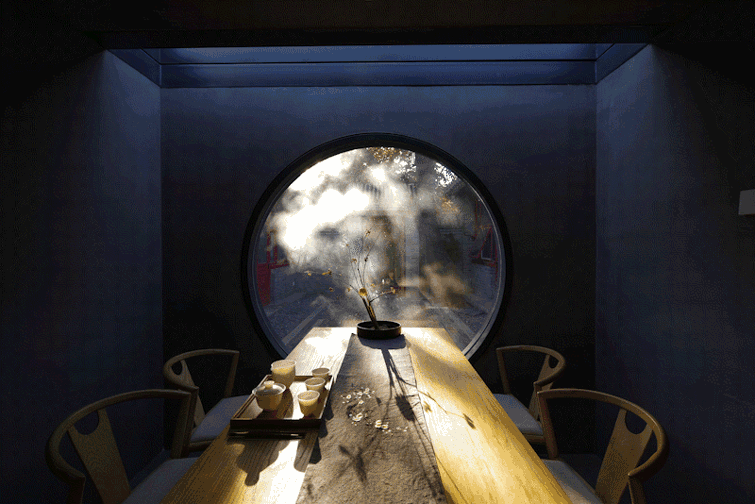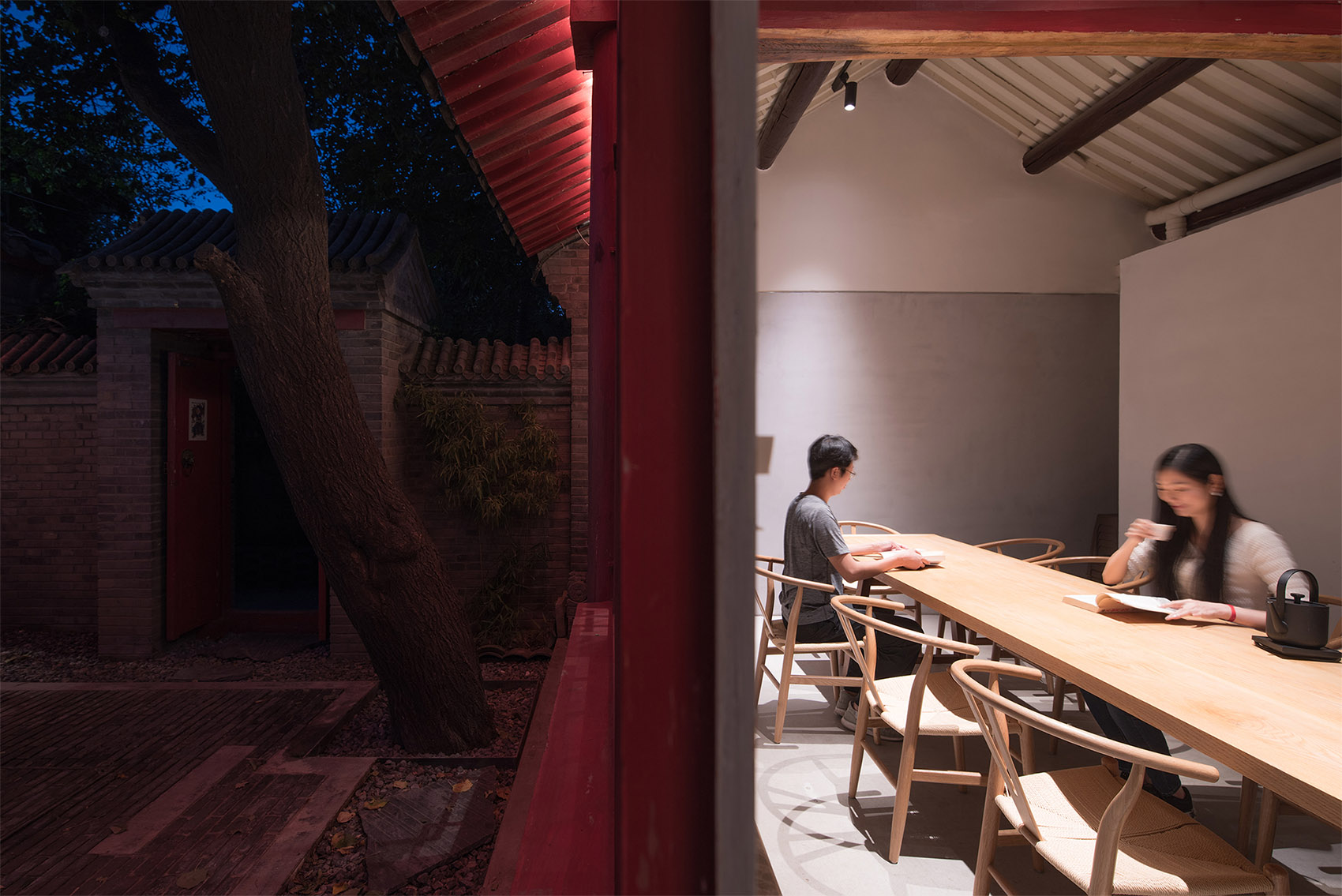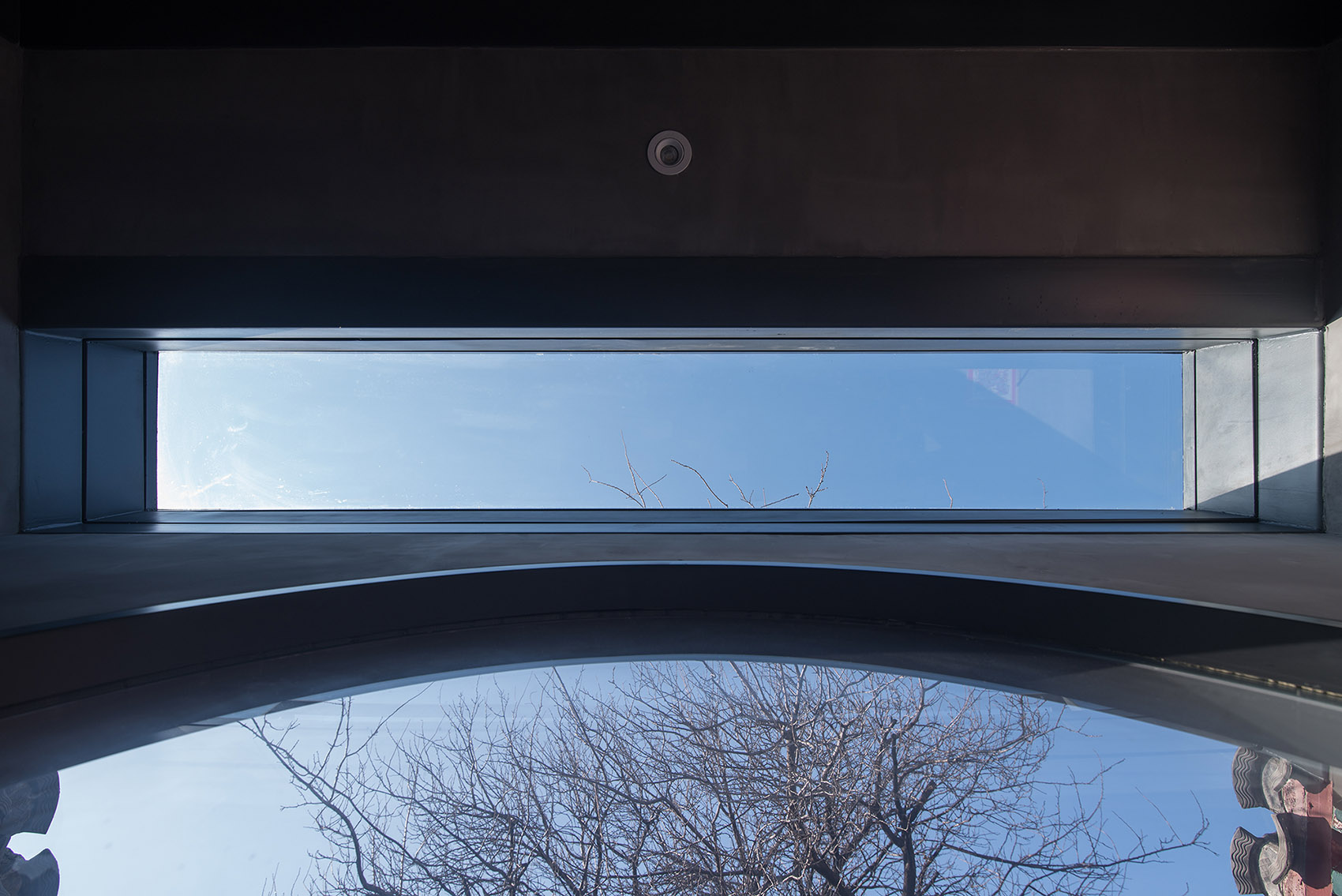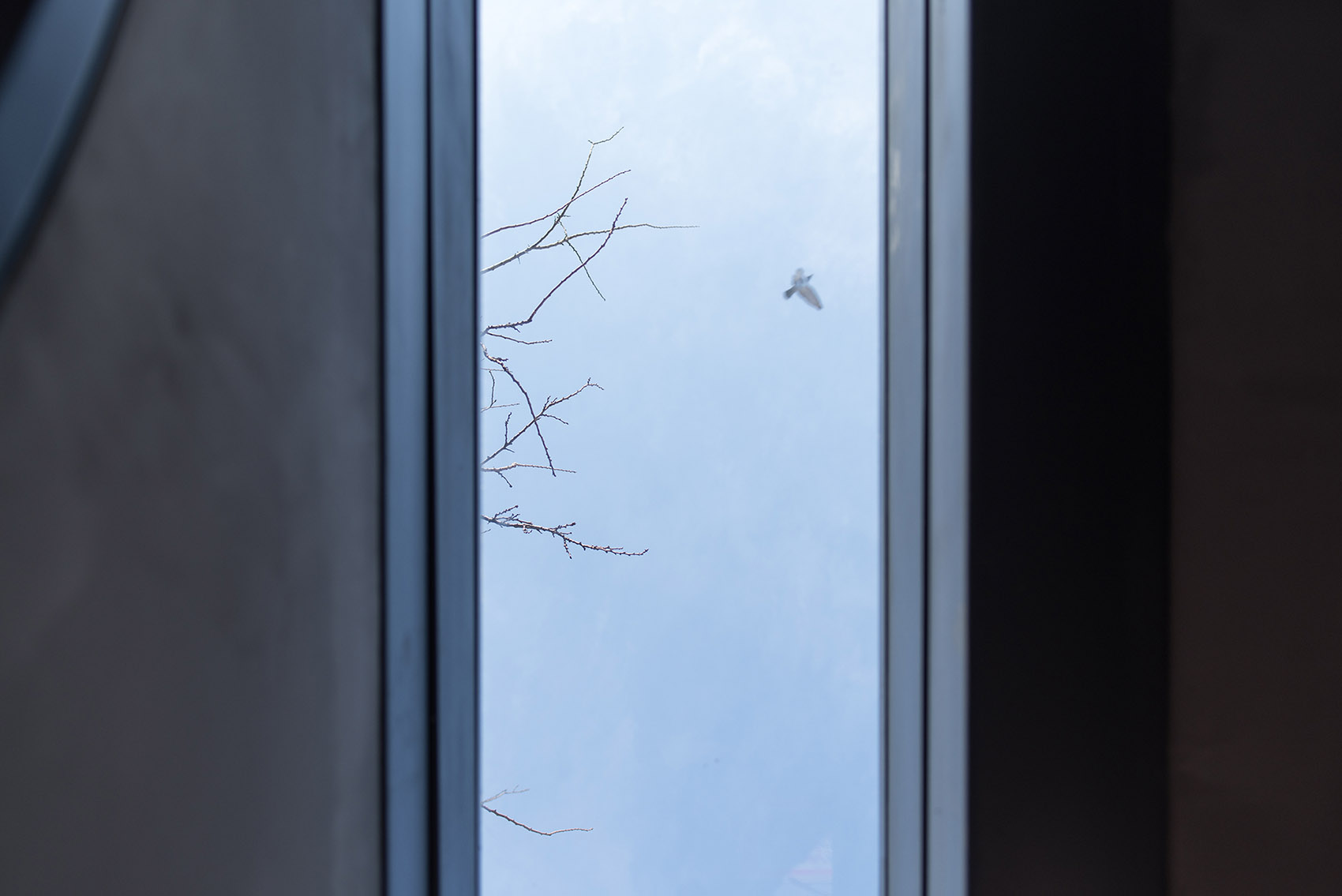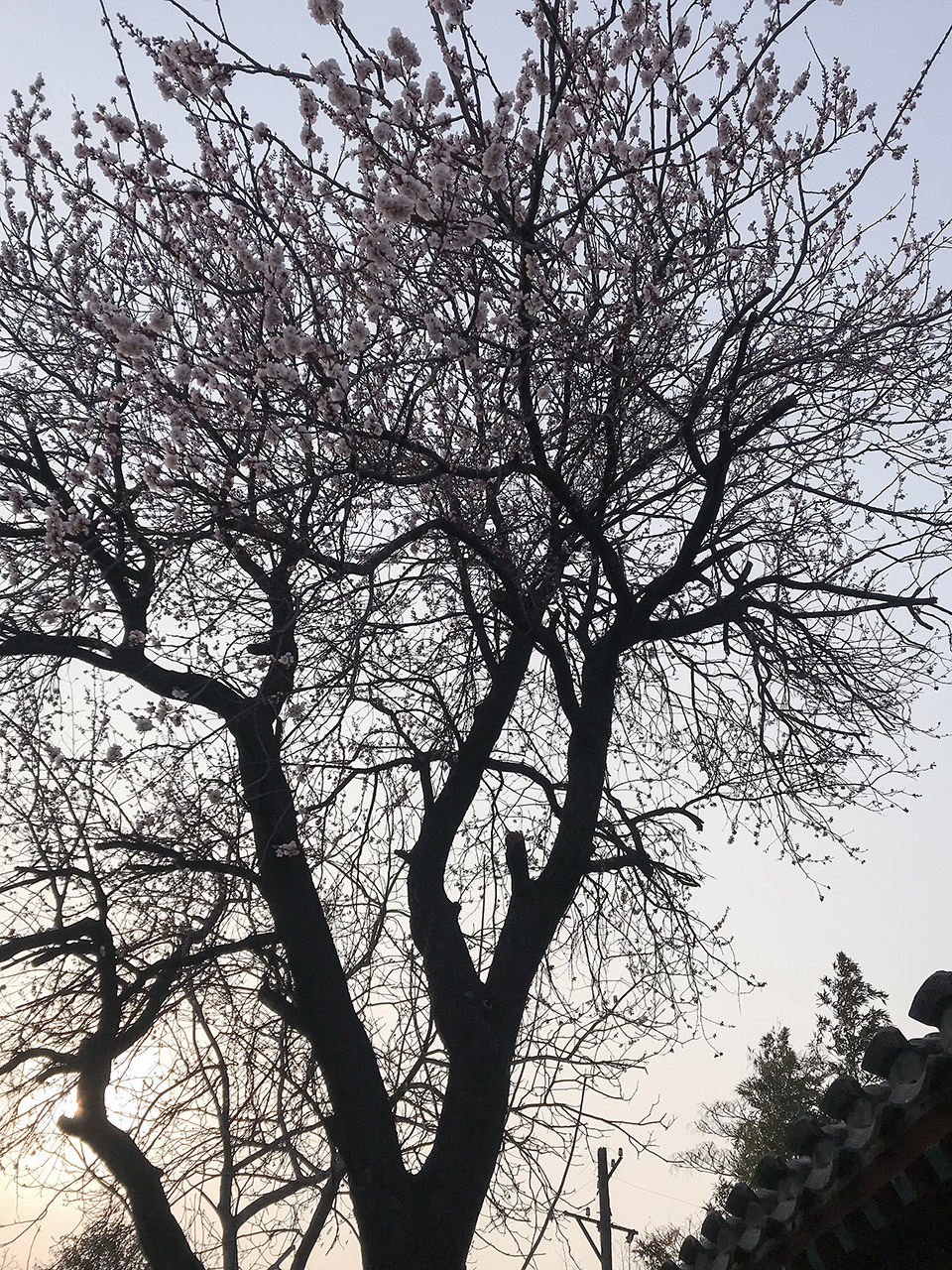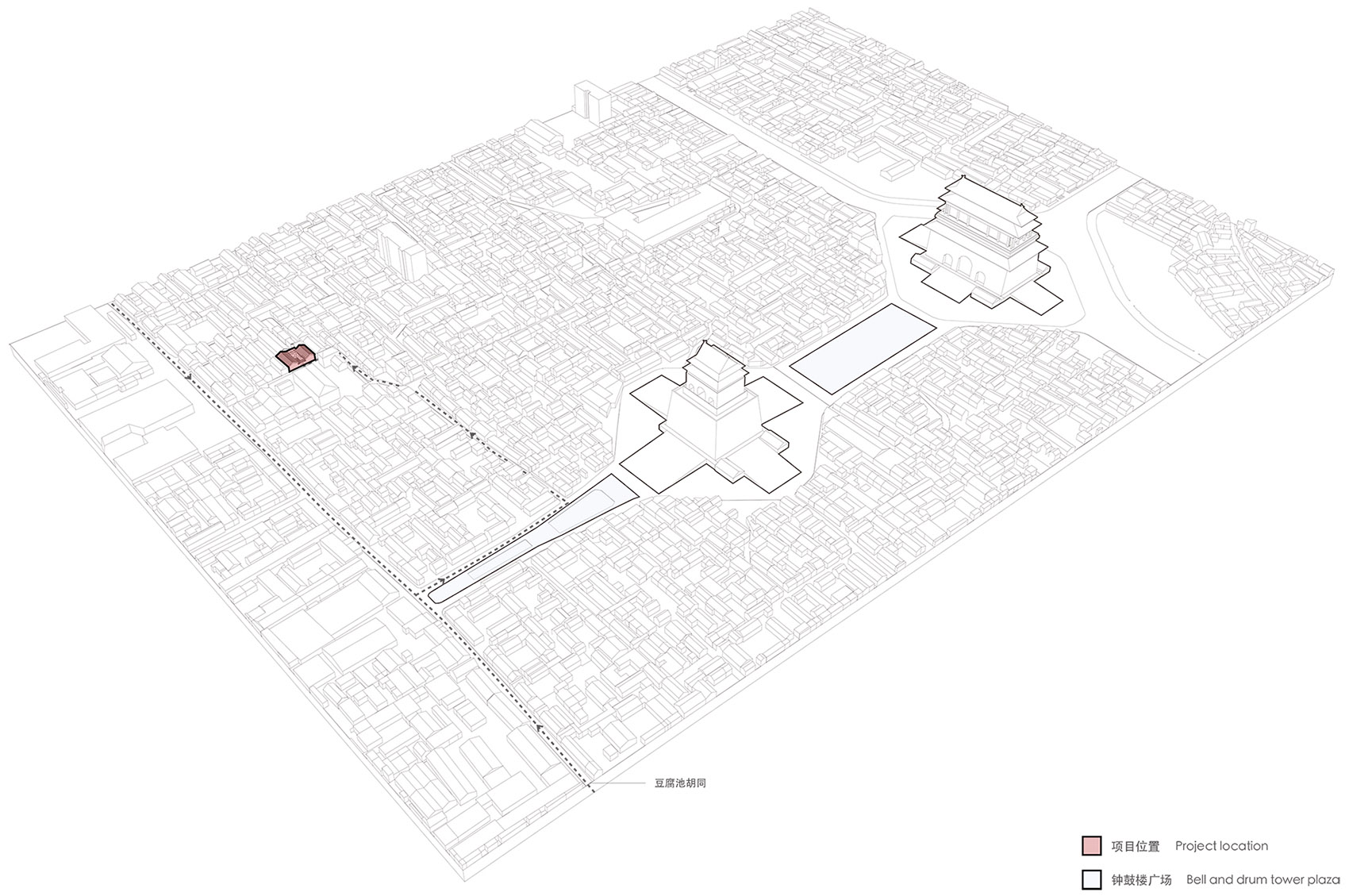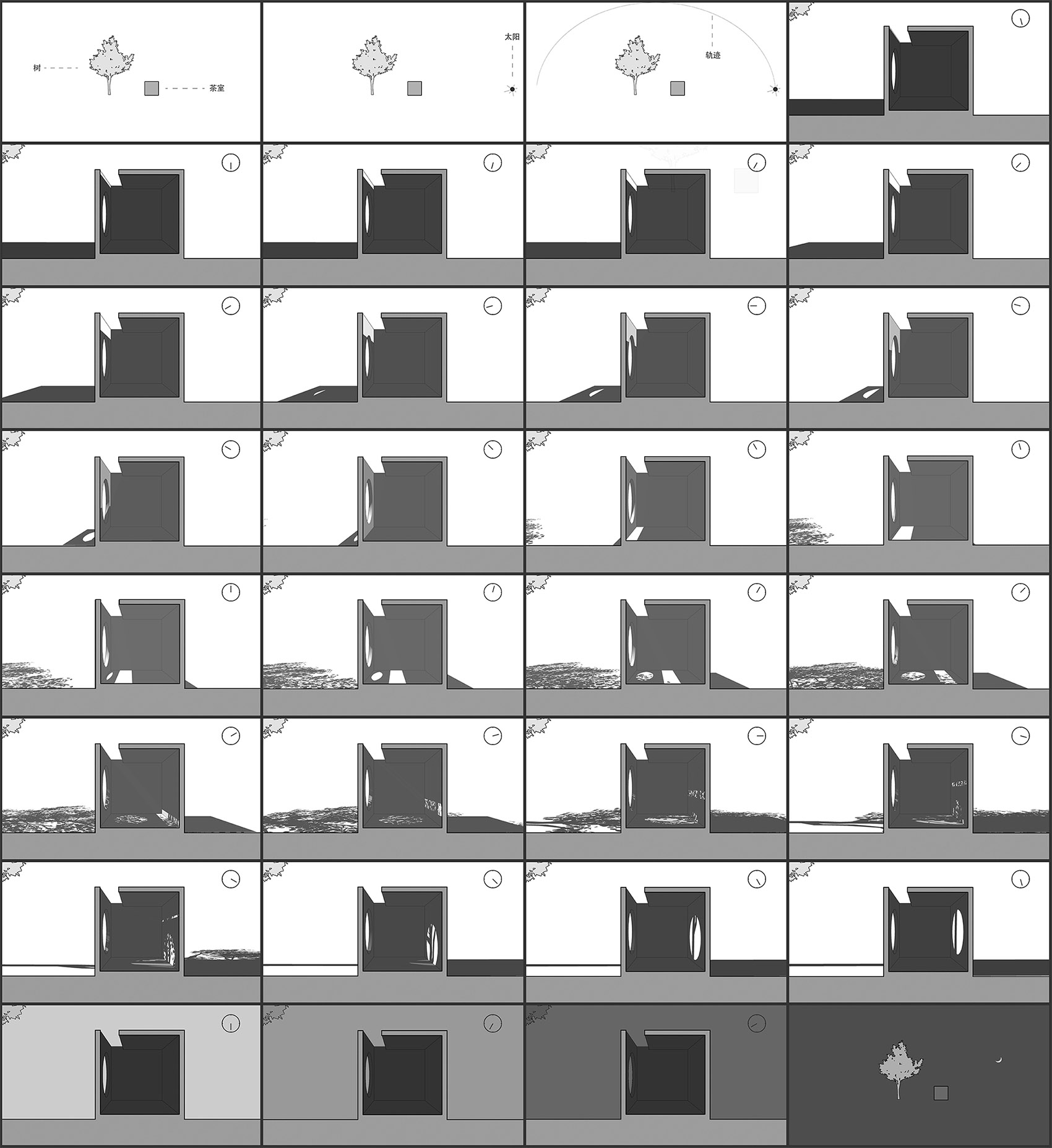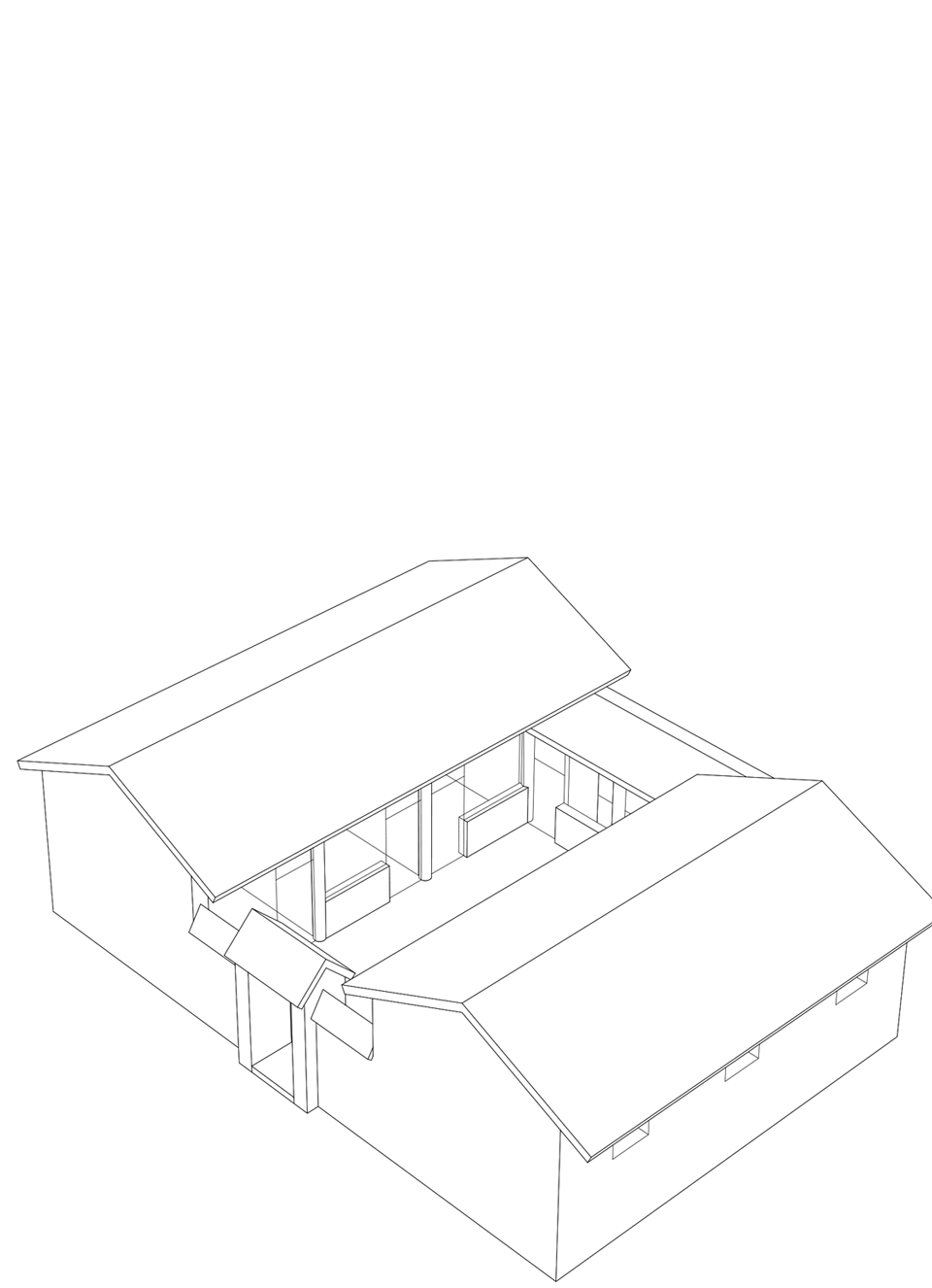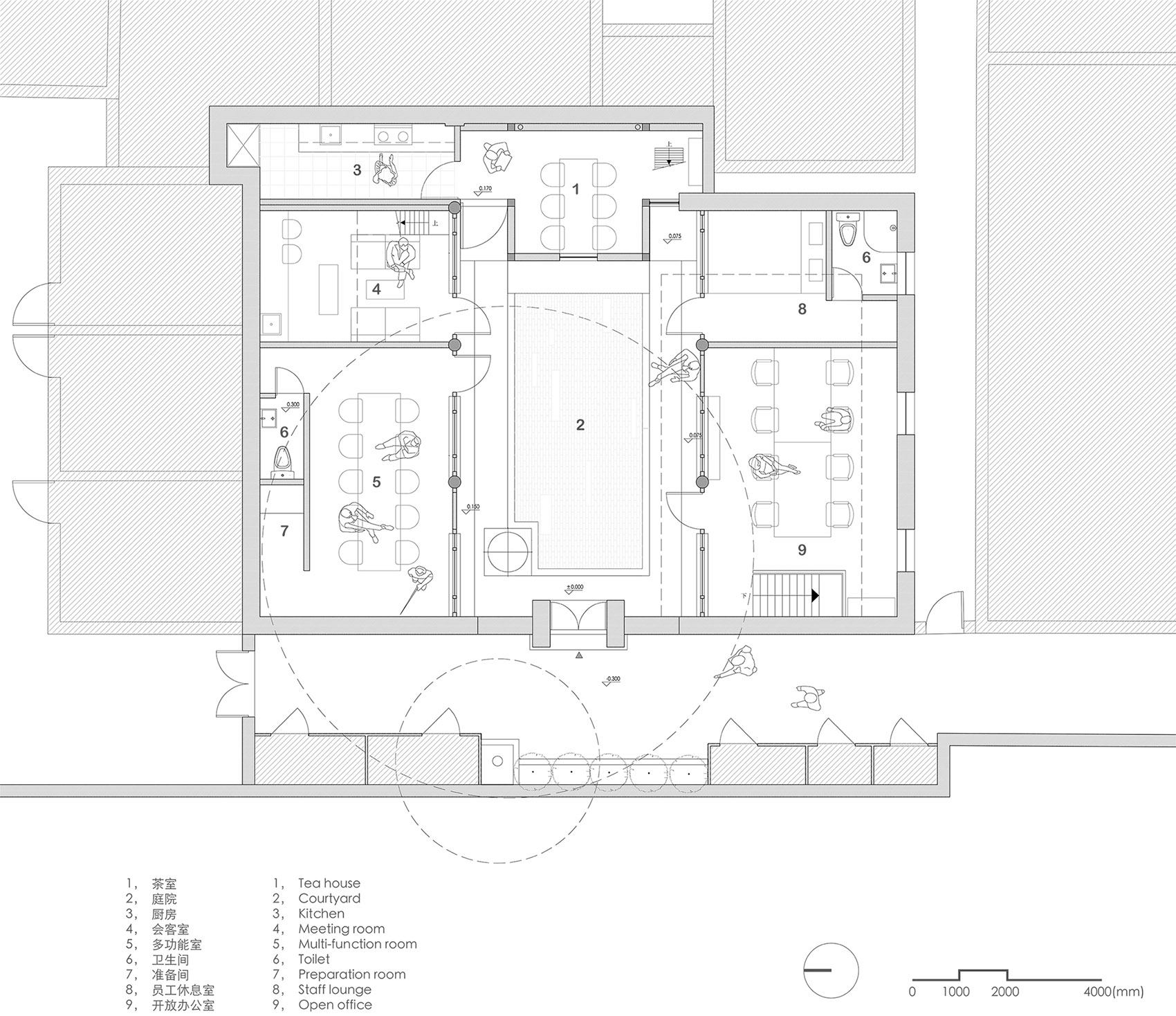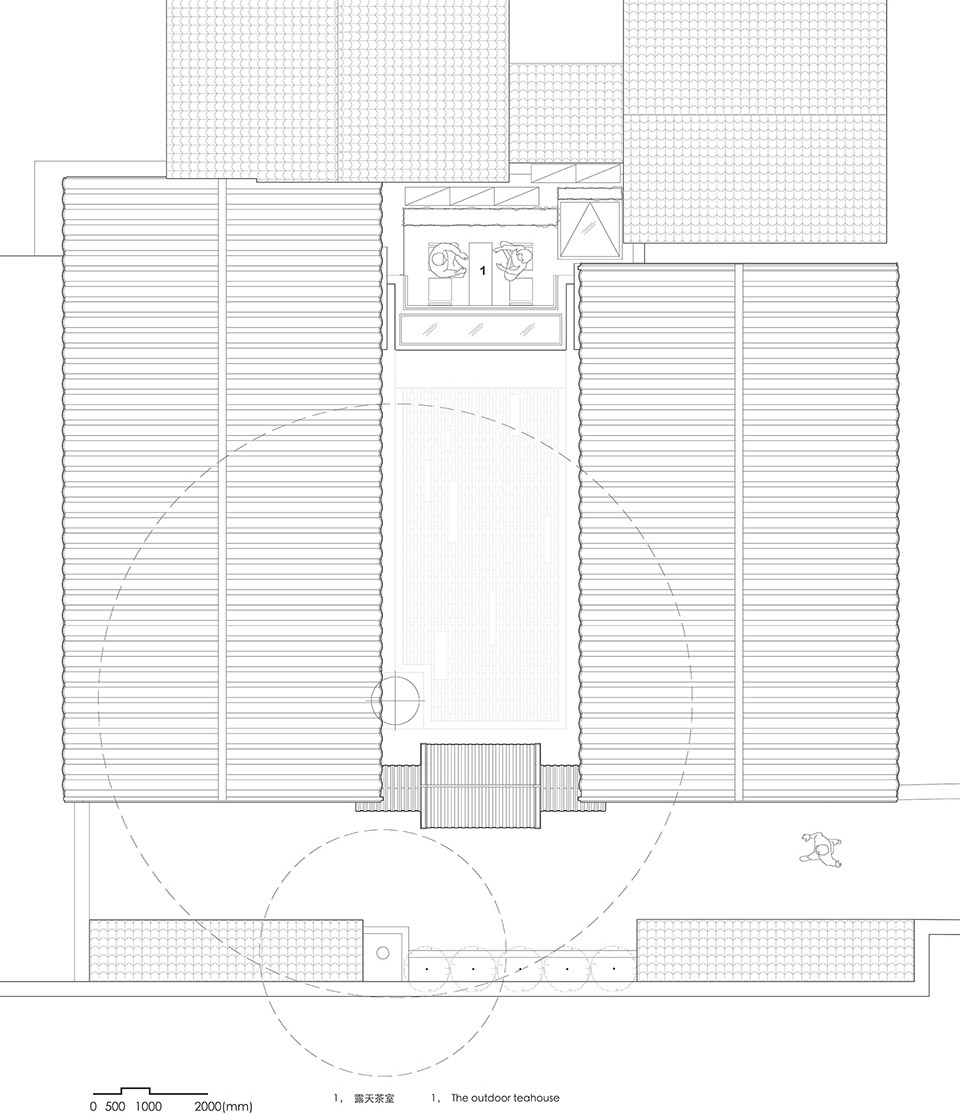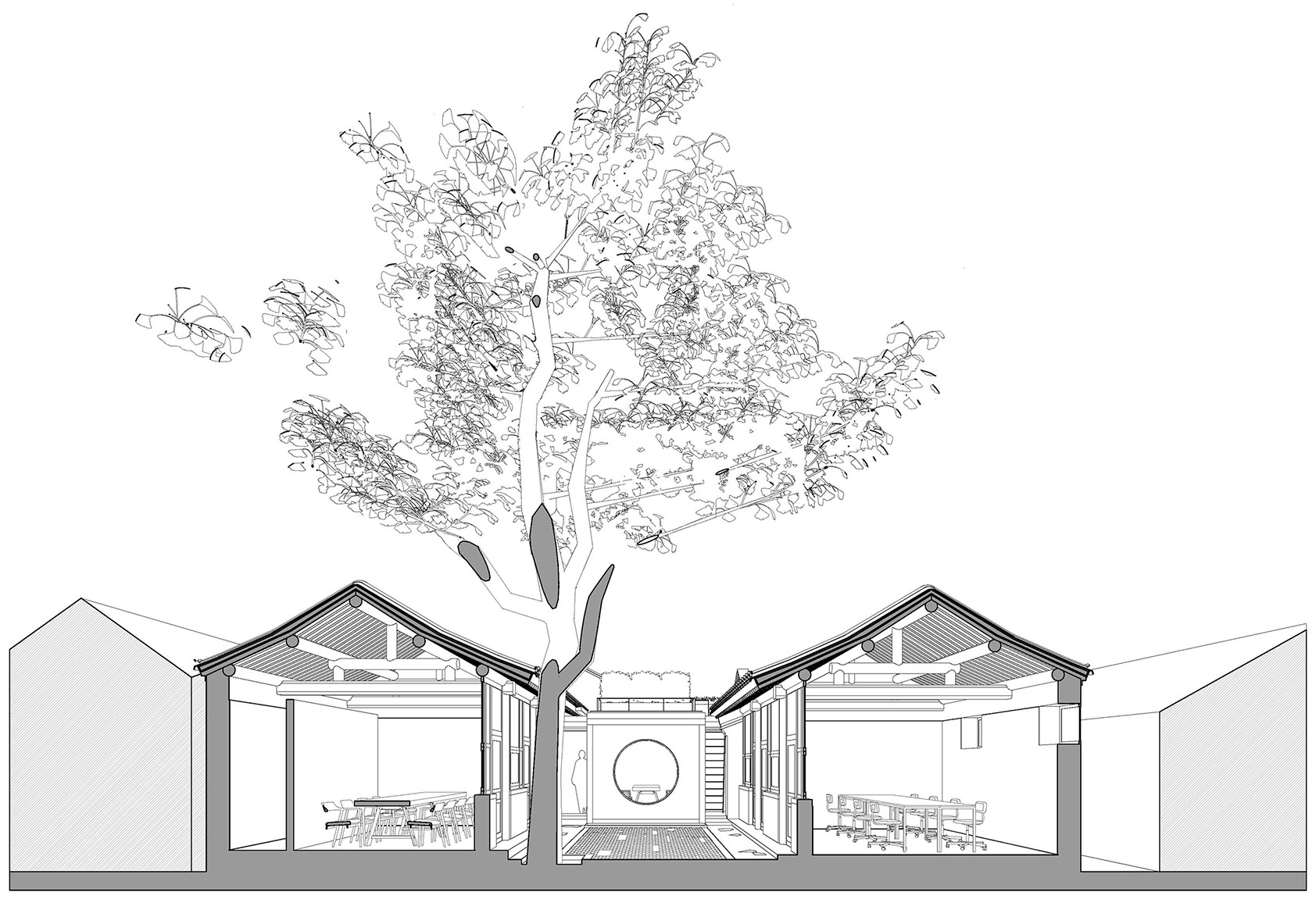四合院更新的微介入——是草厂北巷24号改造关于城市更新的一次设计实践: 以连接城市文脉,结合新的使用群体和功能,探索用较小动作,较低成本的建造,实现四合院微更新的一次尝试。
The micro-intervention of courtyard houses renewal, the reconstruction of No. 24 Caochang North Lane, is a design practice of the urban renewal, exploring the possibility of micro-intervention of courtyard houses with minimal changes and low-cost construction to connect the urban context and integrate the new use groups and programs.
▼改造后的庭院,The courtyard after renovation ©金伟琦
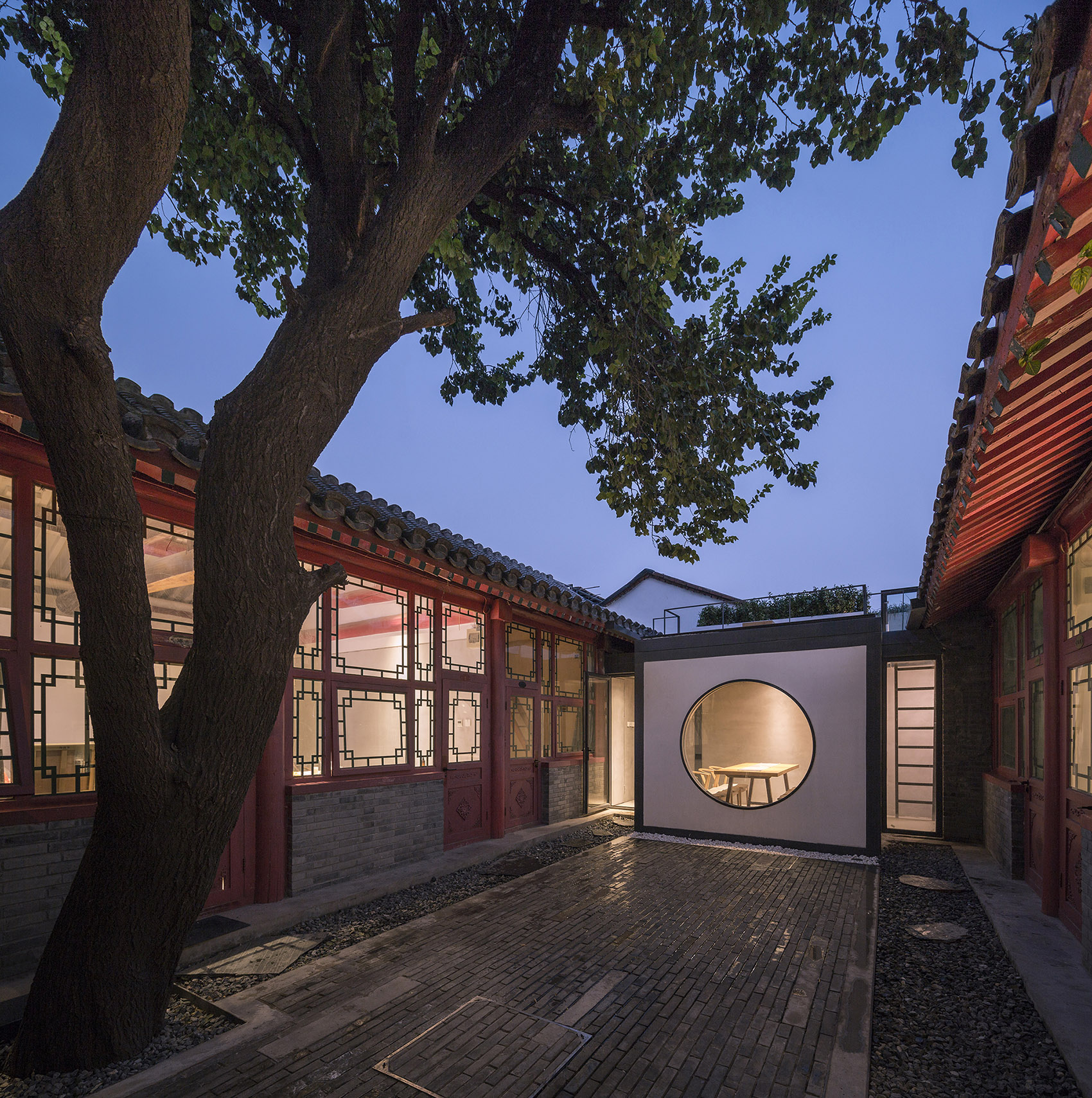
本项目位于草场北巷,毗邻钟鼓楼——作为该区域的标志性建筑,其传统古建筑的气场影响着场地周边的氛围。上百年来钟鼓楼用晨钟暮鼓为城市报时,如今钟鼓虽不再响起,却留下了场地关于“时间”的场所记忆。钟鼓楼广场几乎是到达本次项目基地的必经之地,一路走来,市井嘈杂的胡同在这样的场域氛围下,也变得宁静而有了秩序感。
The project is located at Caochang North Lane, adjacent to the Bell and Drum Tower. As the symbolic building of the area, the traditional Chinese architecture has large impact on its surroundings. With its morning bell and evening drum, the tower has been announcing the time for hundreds of years. Even though the bell and drum are no longer ringing, it has left the site with the memory of “time”. The Bell and Drum tower plaza is on the way to the project. Along the walk, the bustling lanes are becoming quiet and organized in such a neighborhood.
▼总图,Site plan
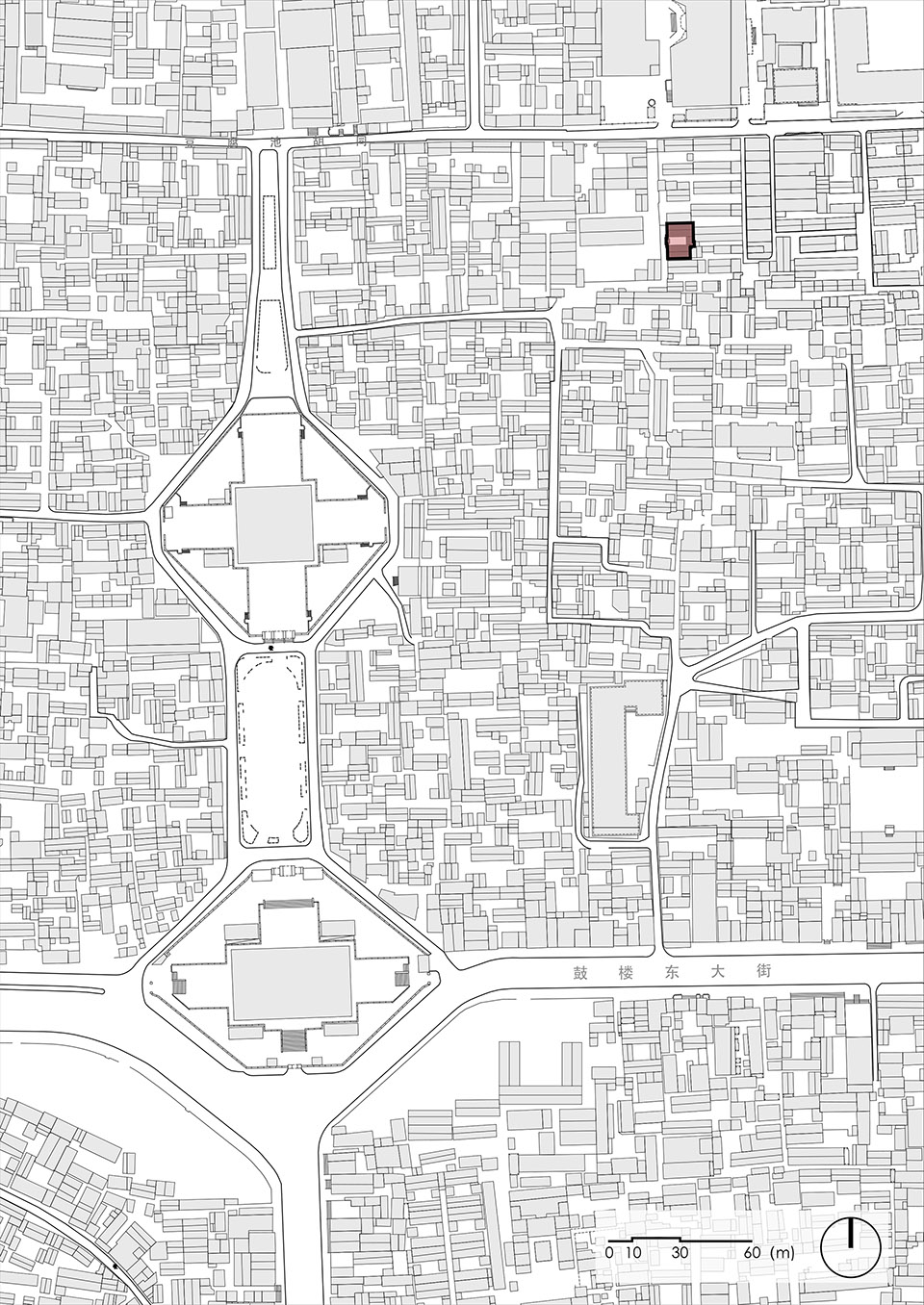
▼场地与钟鼓楼空间关系图,Spatial Diagram of the site and the Bell and Drum Tower
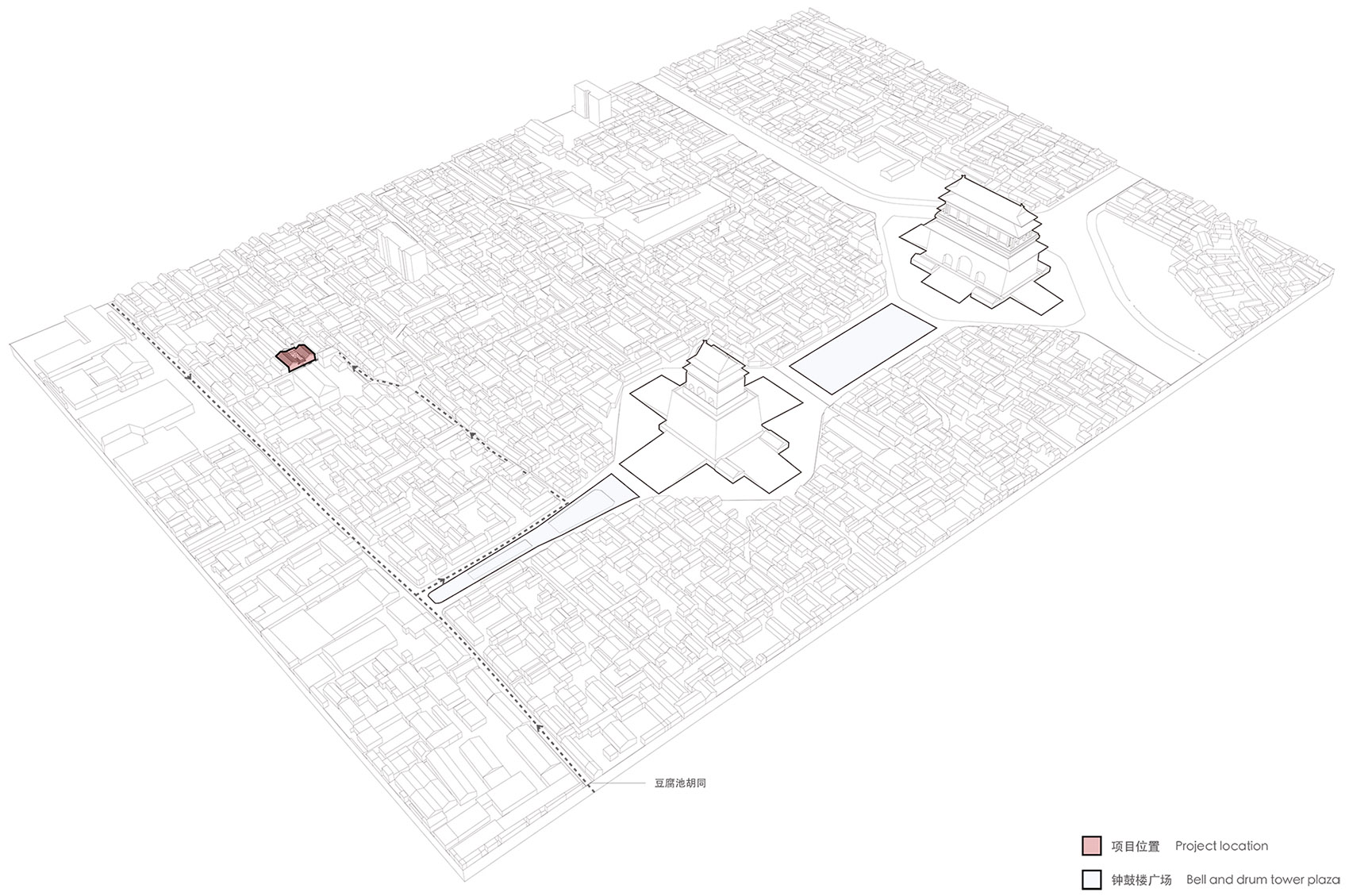
在目前北京二环内的城市发展中,人口结构的的变化是推动古城更新的重要因素,新的使用群体为古城注入新的活力。本次项目的委托方犀牛会是一家闽籍互联网企业。饮茶是福建人生活中必不可少的部分。生活方式决定了茶室在这个空间中的重要性。不一样的生活方式,塑造不同的空间形态。在这里兴造一座茶室是源自生活本身的诗意。
In the current urban development within the second ring road of Beijing, the change of the use group is an important factor to promote the renewal of the ancient city. Along with the people, various cultural tradition and lifestyle inject new energy into the ancient city. Xiniuhui, the client of the project, is a Fujian internet enterprise. Tea drinking is an indispensable ritual for Fujian people. As different lifestyles form different spaces, the lifestyle of Fujian people determines the role of tea house in the space. Building a tea house here originates from the poetic of life itself.
▼小院门口,The entrance of the courtyard ©陈培新
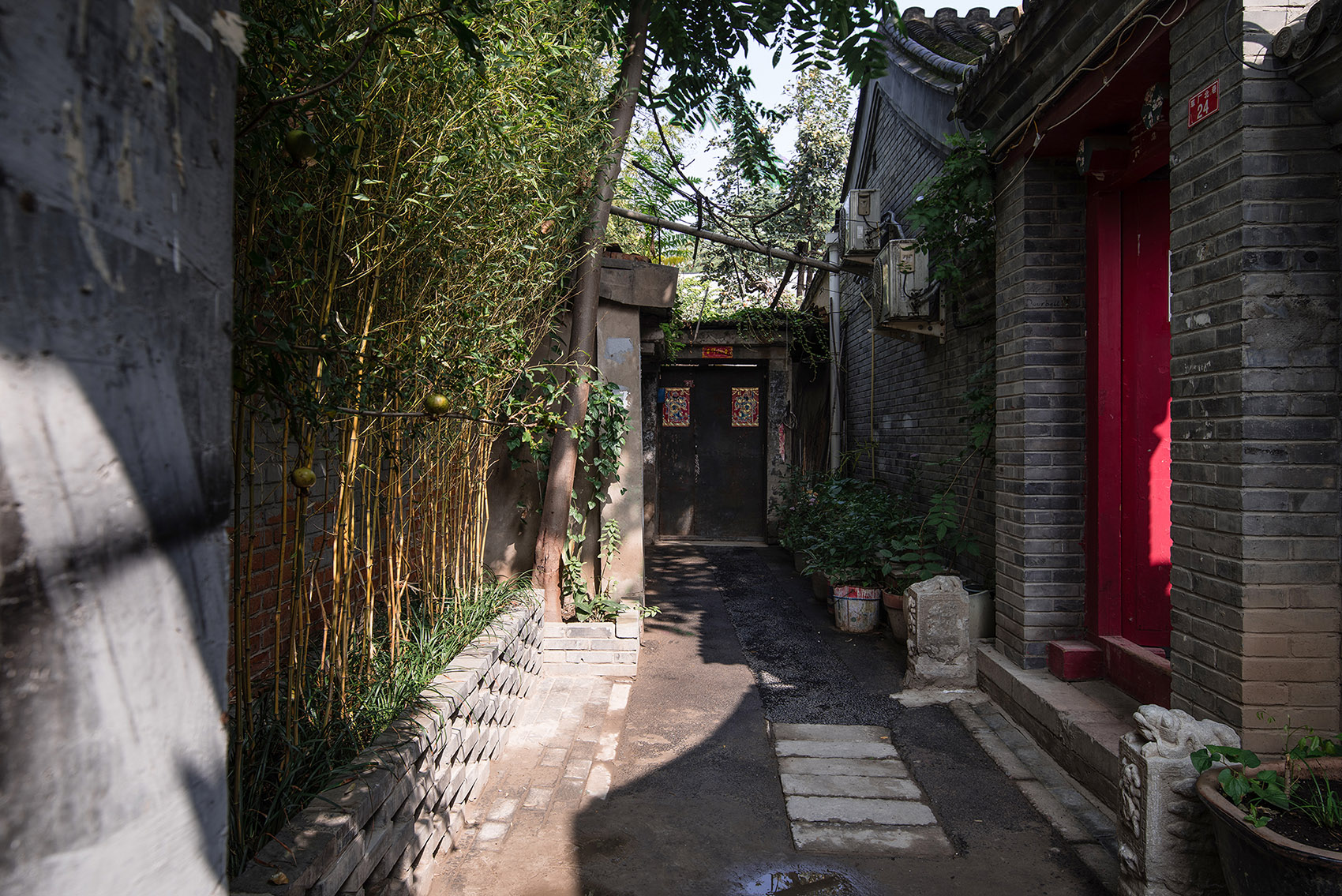
▼鸟瞰图,Aerial view ©陈培新
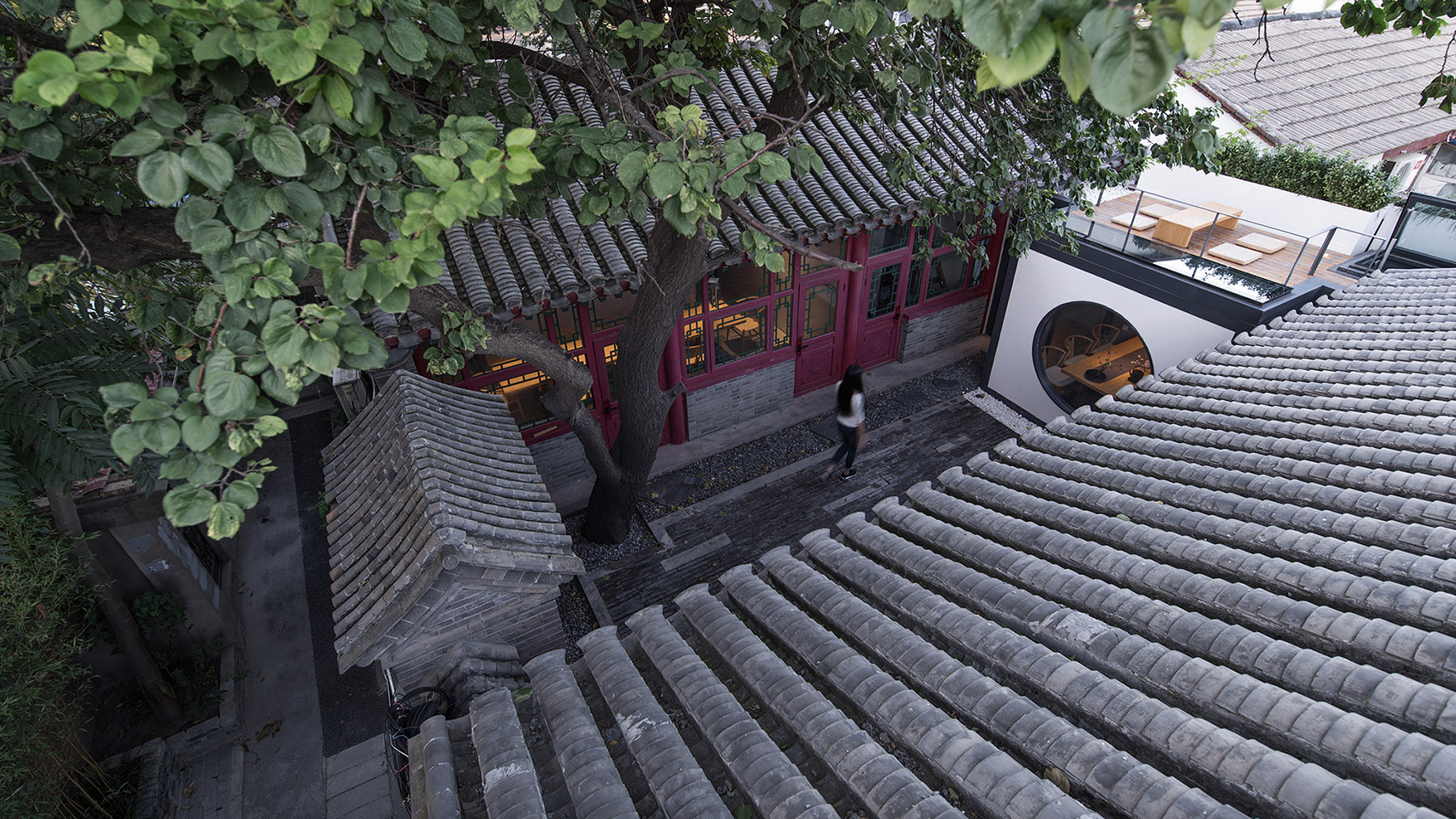
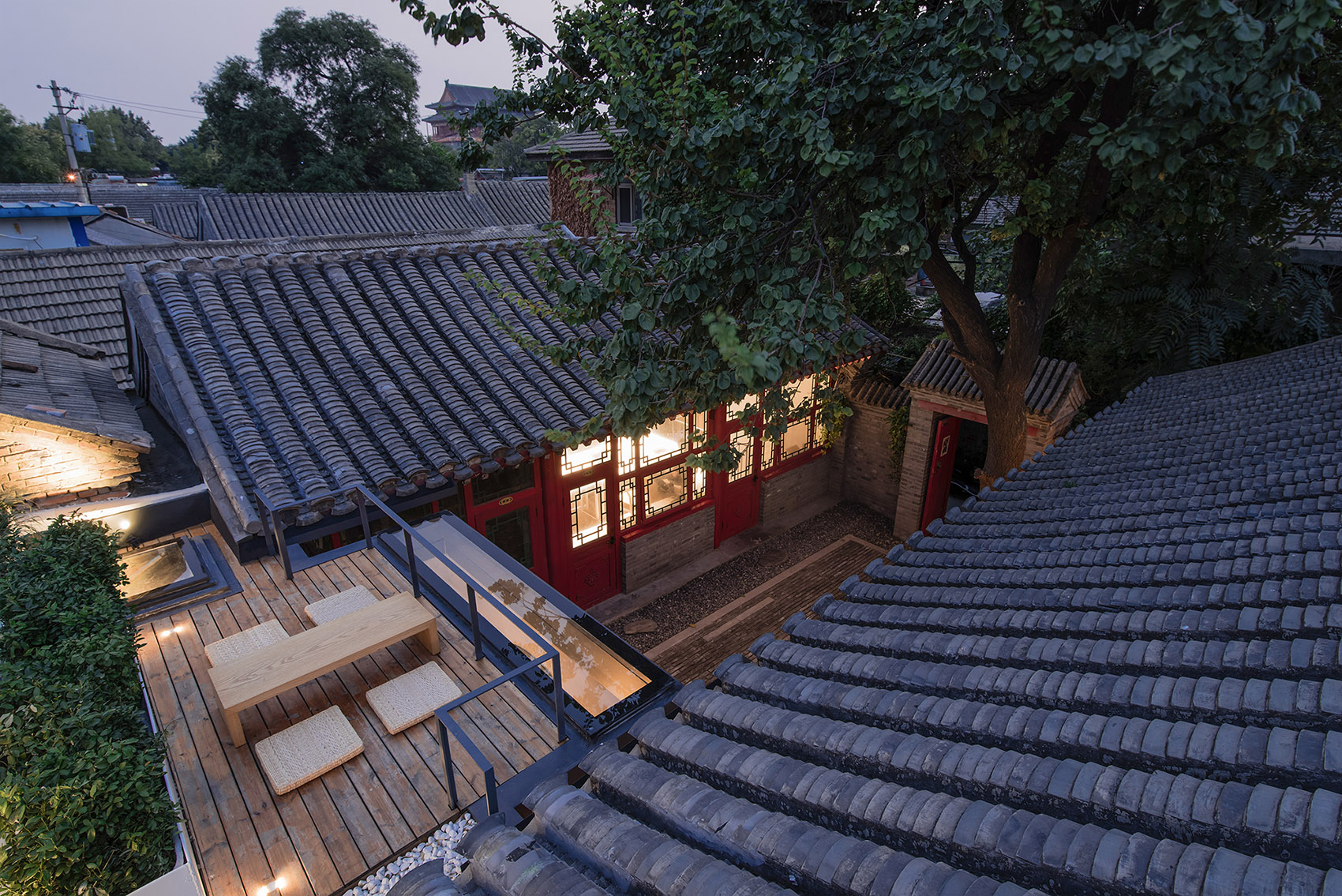
改造前,这里是一家即将被弃用的胡同民宿,拥有7间客房,每个房间风格各异,庭院略显嘈杂,与委托方的需求格格不入。使用功能与需求不相符,而改造预算却十分有限。在这样的情况下建筑师提出通过局部改造(微介入)的策略,在四合院中加入核心功能——茶室,借此改变四合院的整体氛围。
Before the renovation, it was a Hutong homestay about to be abandoned, with 7 rooms of different styles and a slightly busy courtyard, which was incompatible with the client’s needs. The space didn’t match the program while the budget for renovation was quite limited. In this situation, the architect proposed a strategy of partial renovation (micro-intervention) by adding a core function—a tea room into the courtyard, so as to change the spatial quality of the courtyard house.
▼从露台看向庭院,The courtyard view from the terrace ©陈培新
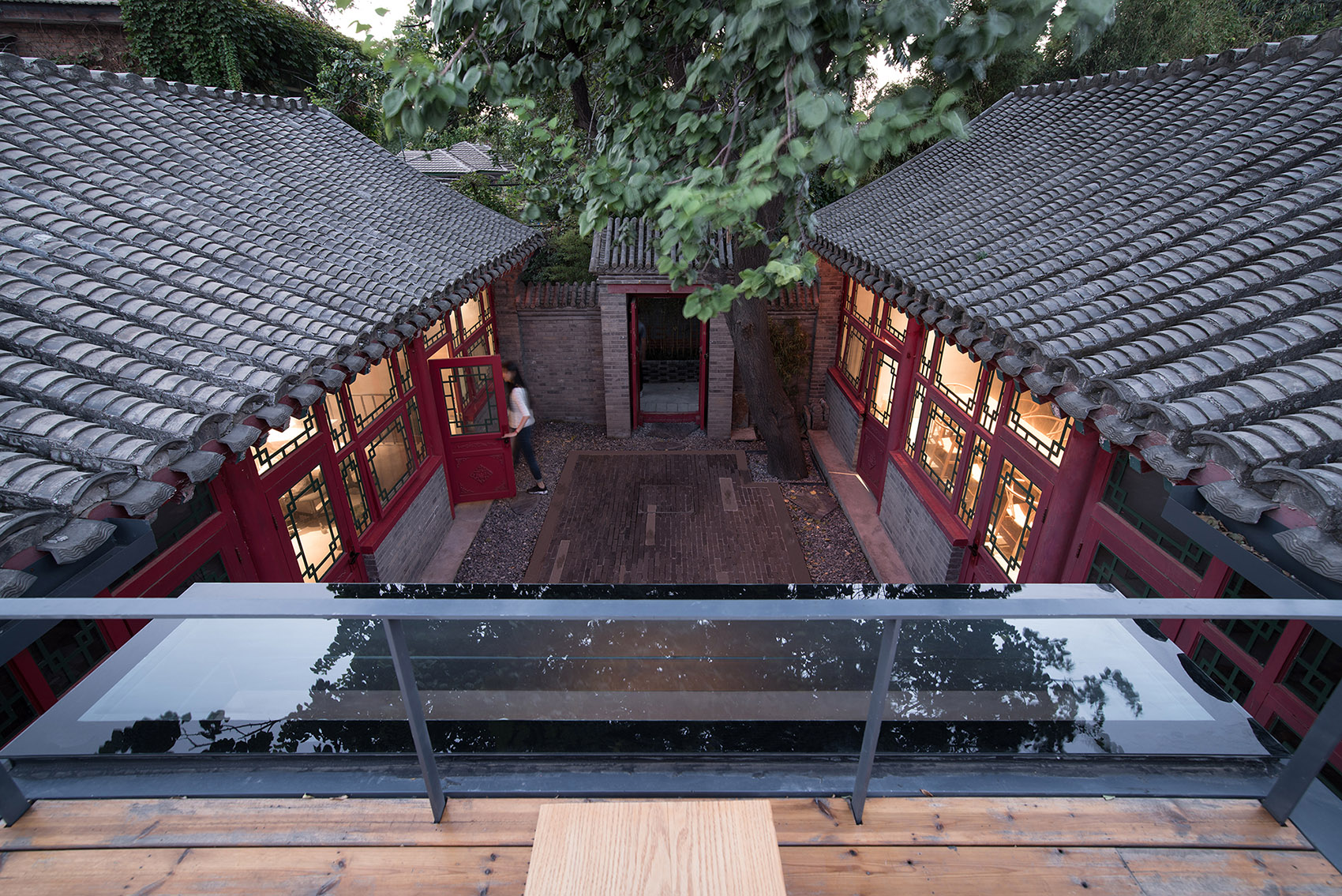
▼改造前的庭院,view of the courtyard before renovation

改造中,只拆除较为破败狭小的东屋、南北房的两道隔断墙及卫生间。置入三个方盒子,一个加于院中,作为茶室;另两个融入南北两房,作为开放办公室与多功能室。其余三个房间,厨房及两个客房基本保留原有格局:一个客房改为小茶室兼会客室,另一个客房作为员工休息室而整体保留。新加部分嵌入到原有四合院中,新旧保有各自的性格。
During the process of renovation, only small portion of the house were demolished: the dilapidated narrow east room, the two partition walls of the south and north room and the toilet. Three boxes were added. One was added in the courtyard as a tea room and the other two were integrated into the north and south rooms as an open office and a multi-function room. The rest three rooms, one kitchen and two guest rooms were basically kept in the original layout with one guest room converted into a small tea room and meeting room and the other retained as a staff lounge. As the new part was embedded into the original courtyard, both the original and new parts maintained their own characteristics.
▼设计生成,Design generation (动图GIF)
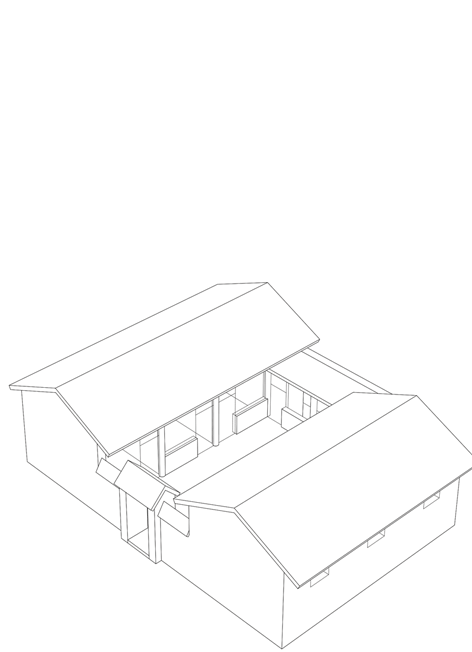
▼庭院一侧的多功能室,view of the multi-function room from the courtyard ©陈培新
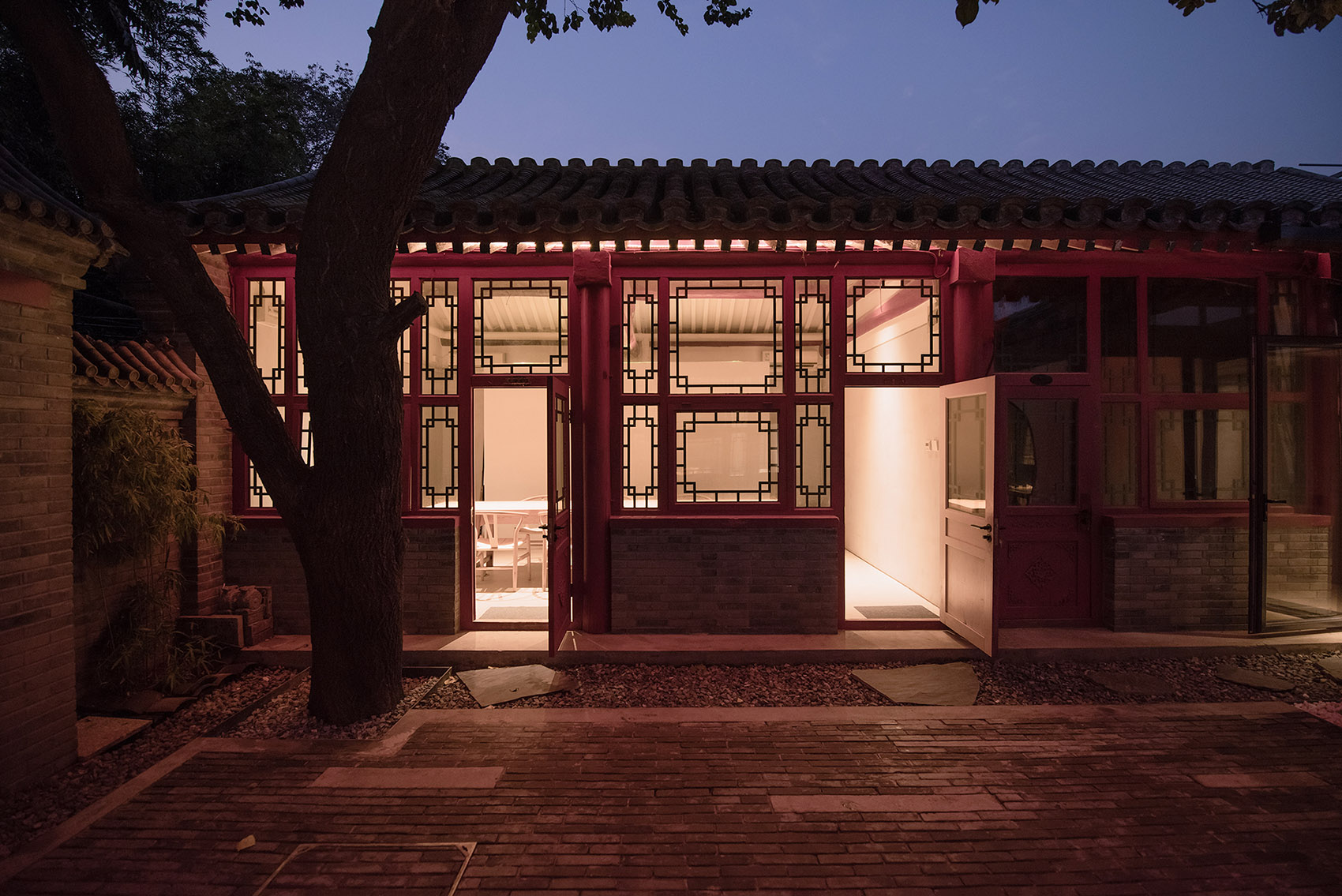
茶室设计的思路源于对场地中“时间”的思考。建筑师有意在这里连接杏树、茶室与太阳,探讨“时间”在这个场地中所带来的变化。树与茶室相距6米,树冠半径正好在5-6米之间,树高13米。太阳一天的移动使院中的树影随之而变:午后树影开始进入茶室圆窗,并在茶桌上产生粼粼波光,暗调的茶室也由于光线的进入而产生特别的仪式感,在光影游走中,于3-4点之间达到高潮。
The idea of the tea house comes from the contemplation on “time” on the site. The architect intends to connect the apricot tree, the tea house, and the sun to explore the changes brought by “time” to this site. The distance between the tree and the tea house is 6 meters. The crown radius of the tree is 5 to 6 meters and the tree is 13-meter high. The movement of the sun throughout a day projects the shadows of tree in the courtyard, which comes through the round window of the tea house in the afternoon, reflecting sparkling lights on the table. A sense of serenity is emerges in the room as the light enters, which reaches a climax in the lights and shadows around 3 to 4 in the afternoon.
▼茶室与树一天的光影关系分析图 The shadow diagram between the tea house and the tree in a day
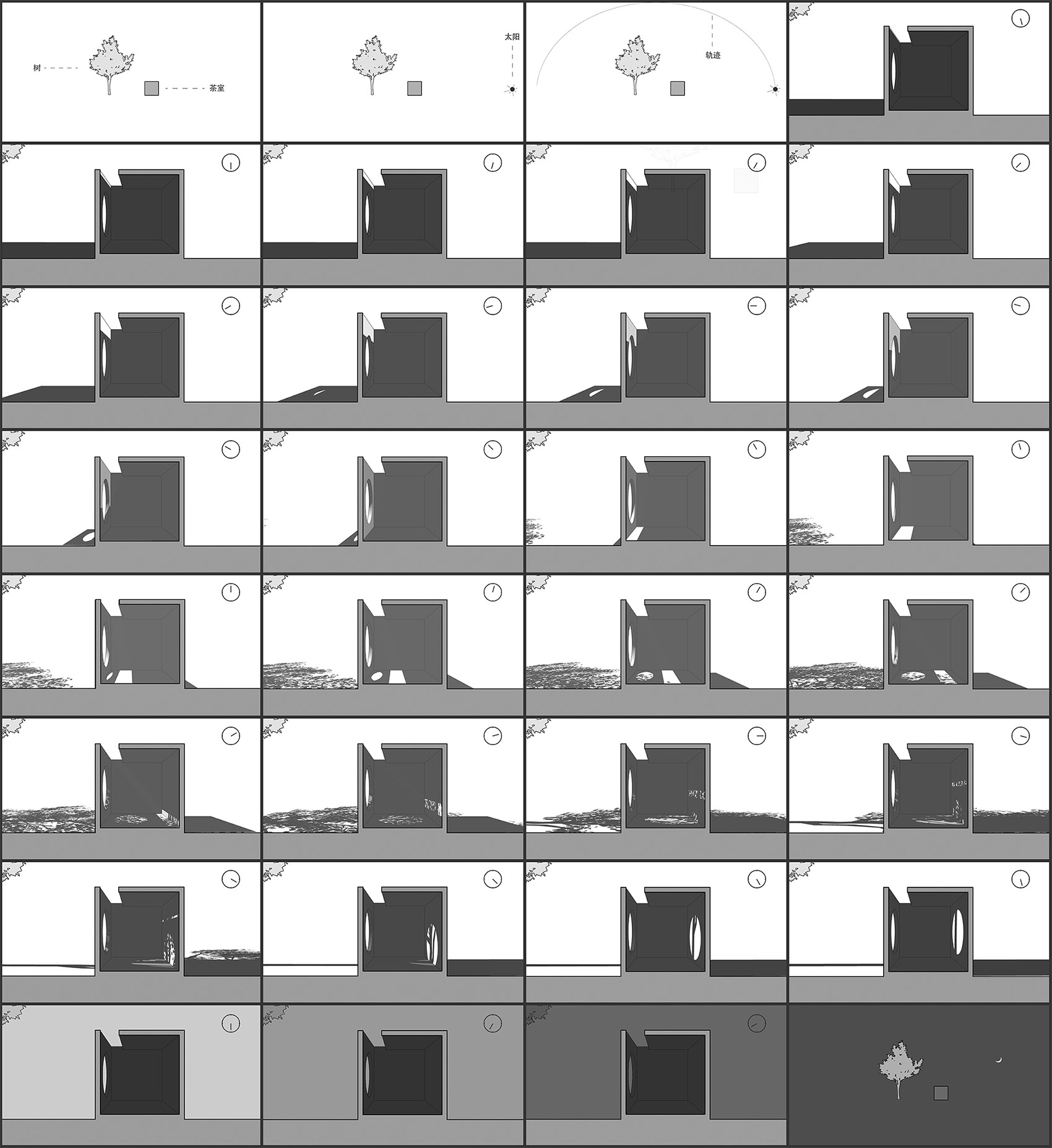
▼午后的茶室,The tea house in the afternoon ©陈培新
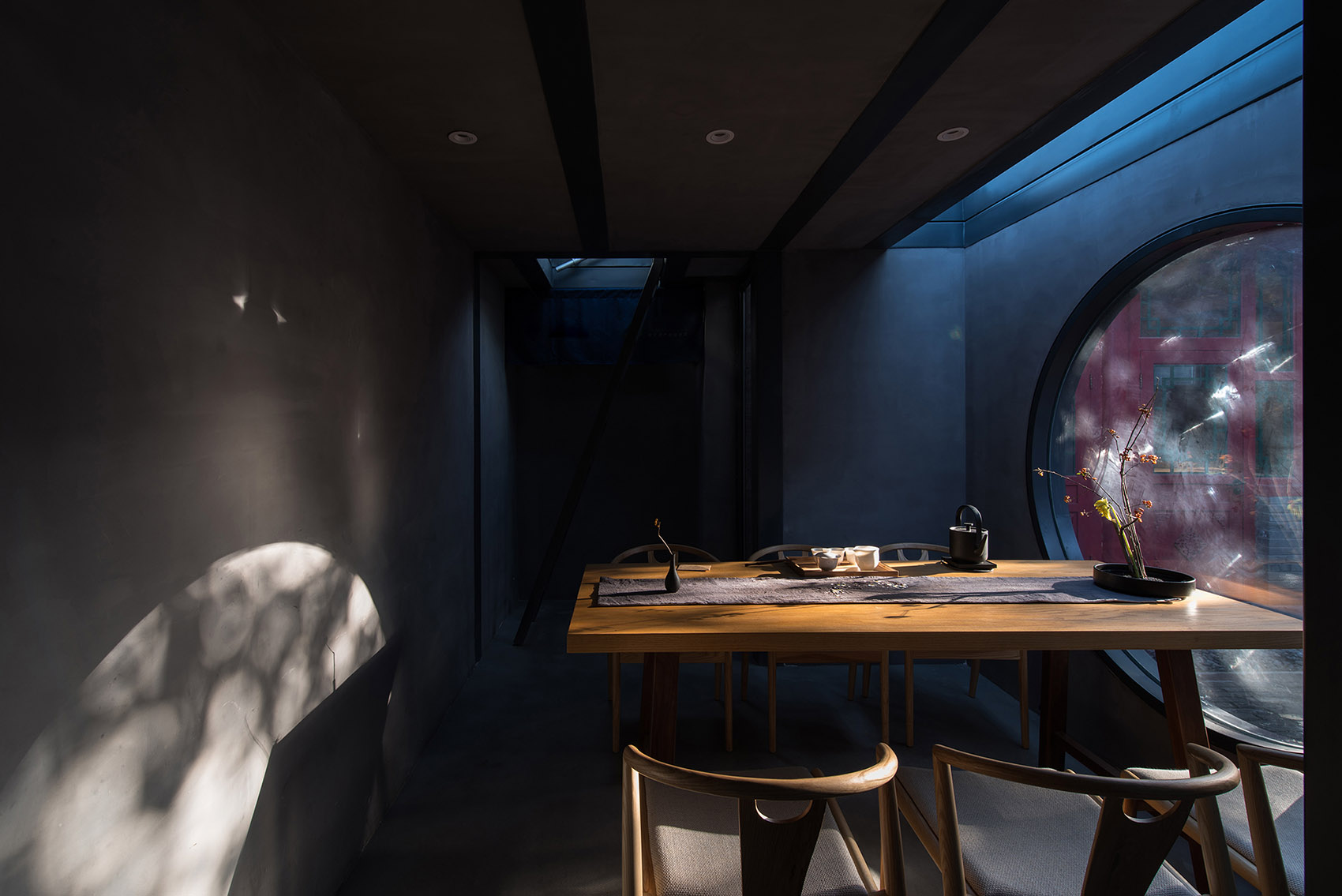
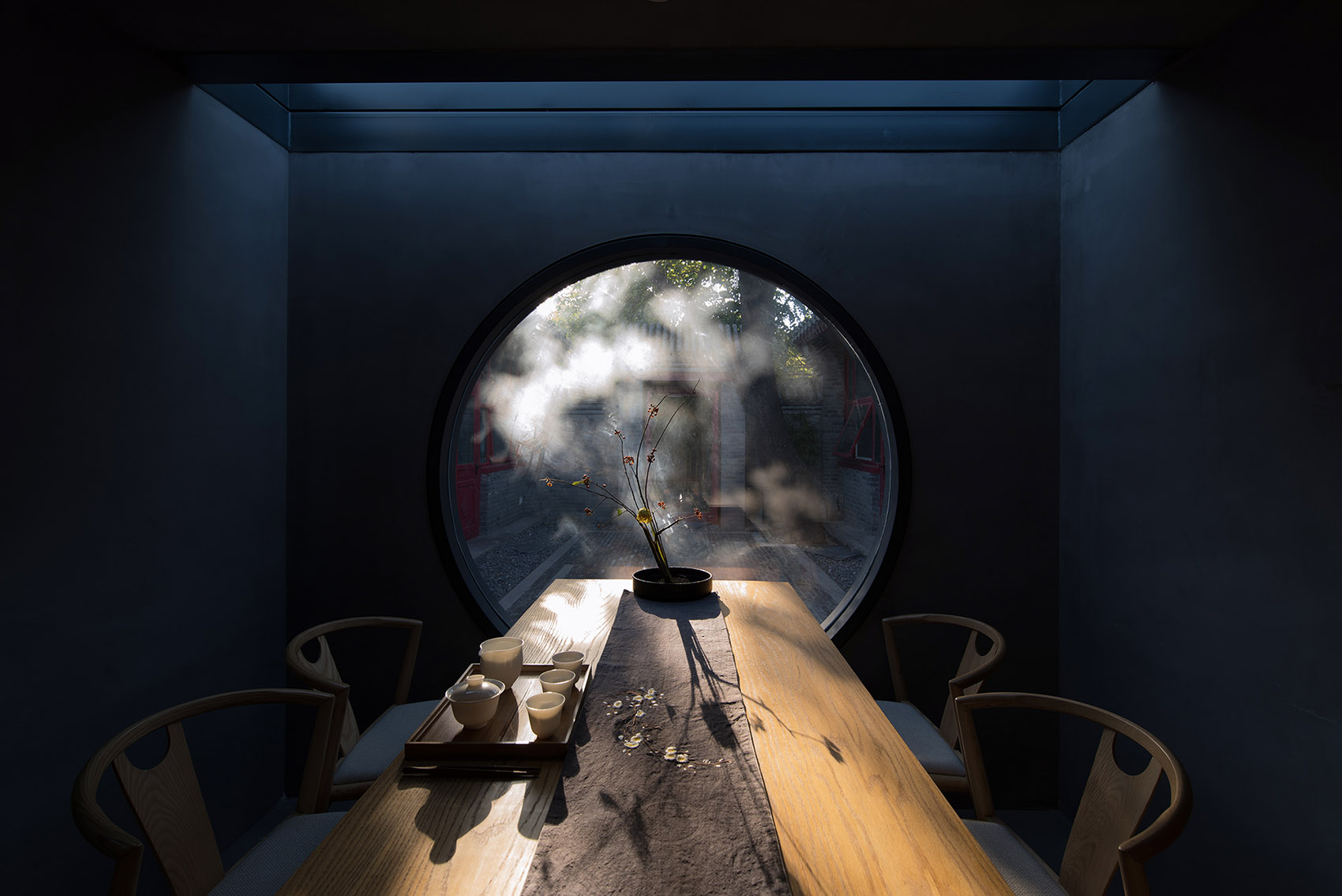
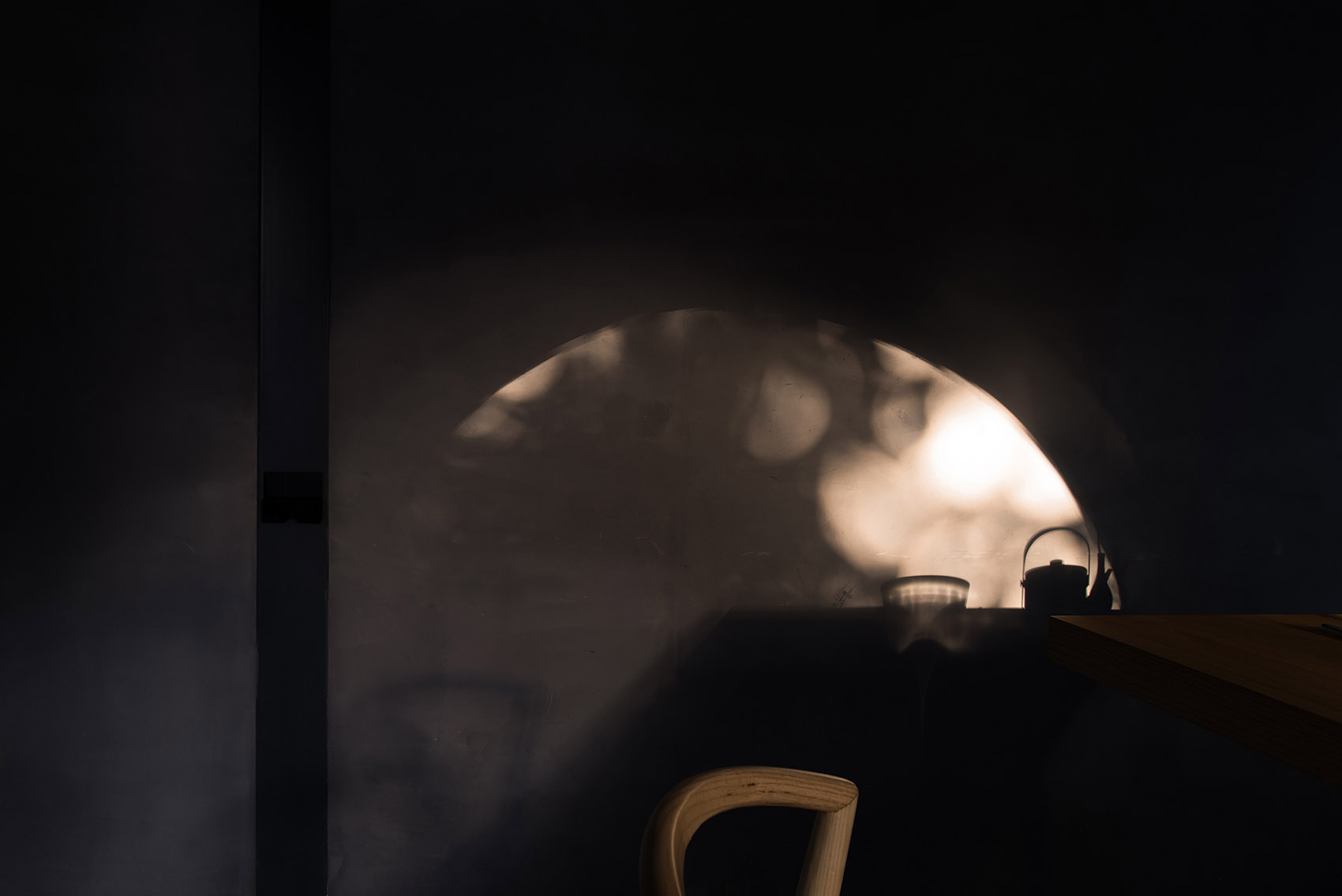
▼院子内一天光影变化 , The changes of light and shadow in the courtyard throughout a day ©陈培新
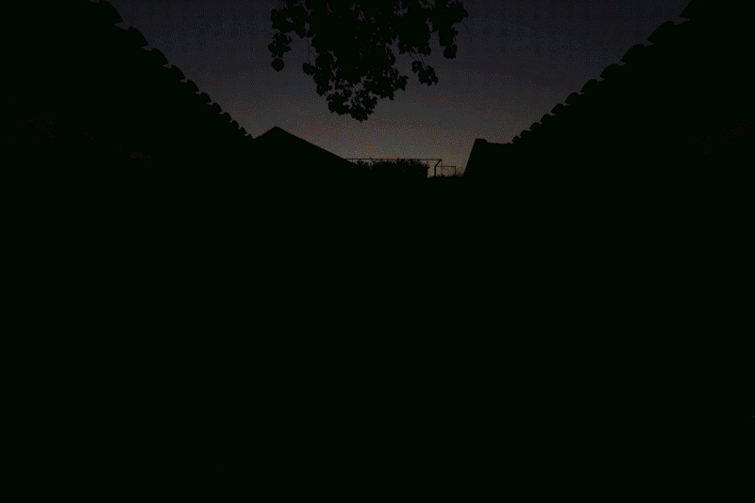
▼茶室内下午光影变化,The changes of light and shadow in the tea house in the afternoon ©陈培新
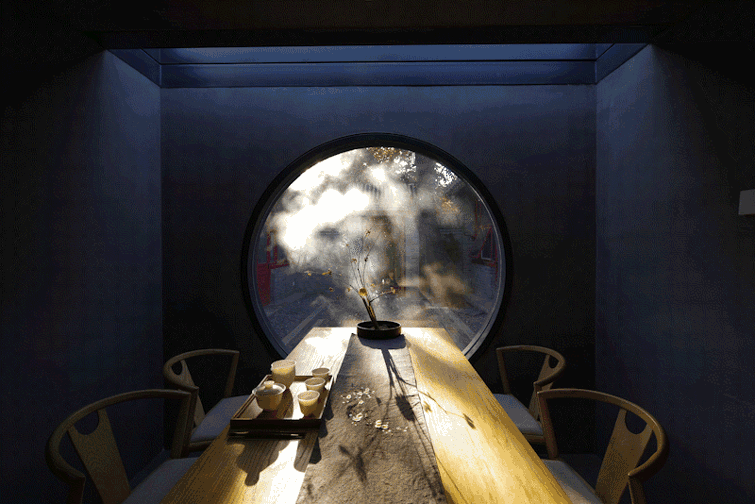
圆形窗的设置,是对茶室空间虚与实的思考,即充当一个光线的收纳器,也是对视线的引导,在透与不透之间,增加院子的空间层次。由外而内,茶室是院中对景;由内而外,茶室是沟通人与自然的媒介。
The circular window is out of the consideration of the void and solid space of the tea house, which acts as a receiver of light, and guides the sight at the same time so that it increases the spatial level of the yard. While looking from the outside to the inside, the tea house is the opposite scenery of the courtyard; from the inside to the outside, the tea house is the medium of communication between man and nature.
▼树影投上开有圆窗的白墙,The tree shadows on the wall with round window ©陈培新
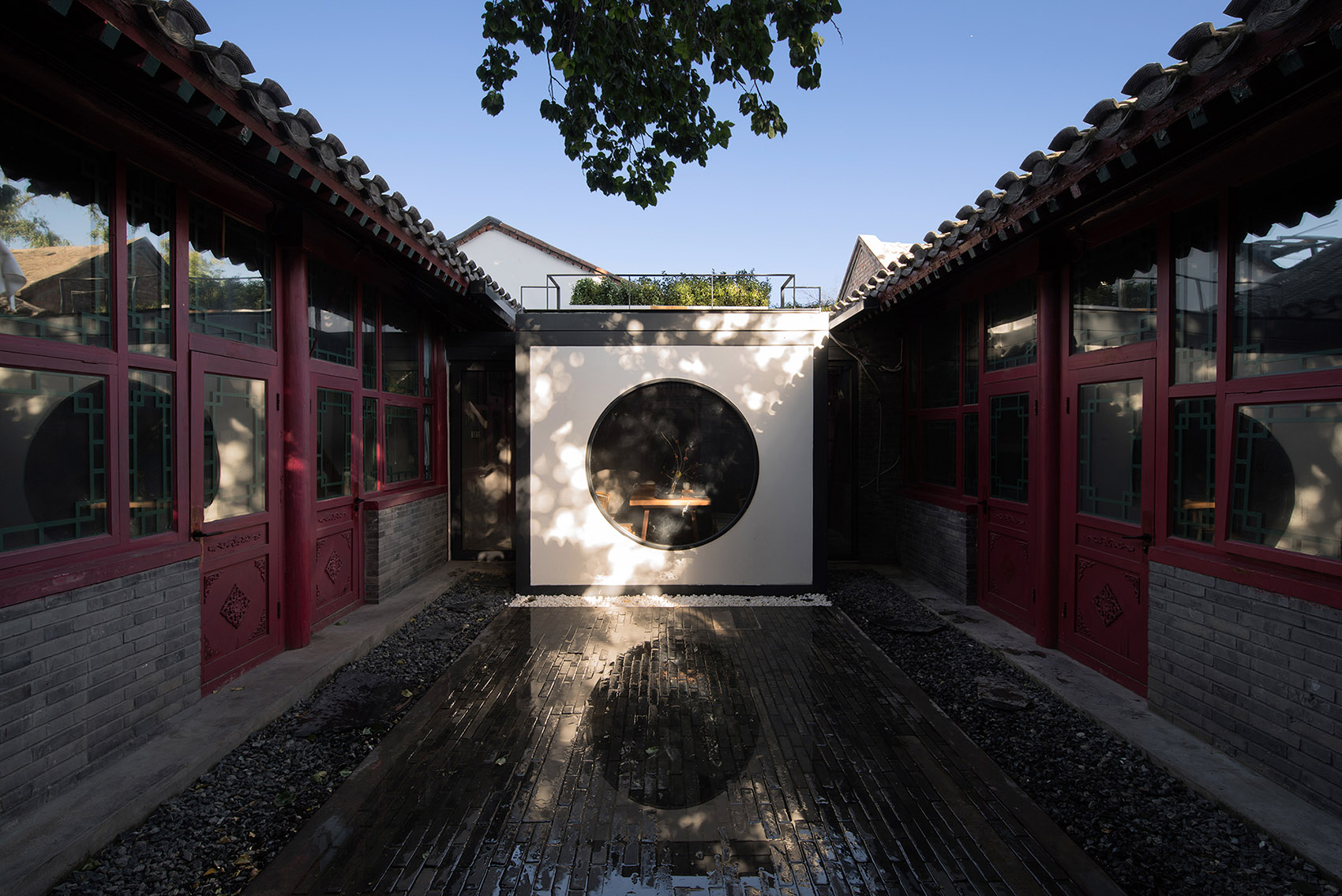
▼茶室内部看向院子,Looking at the courtyard from the tea house ©陈培新
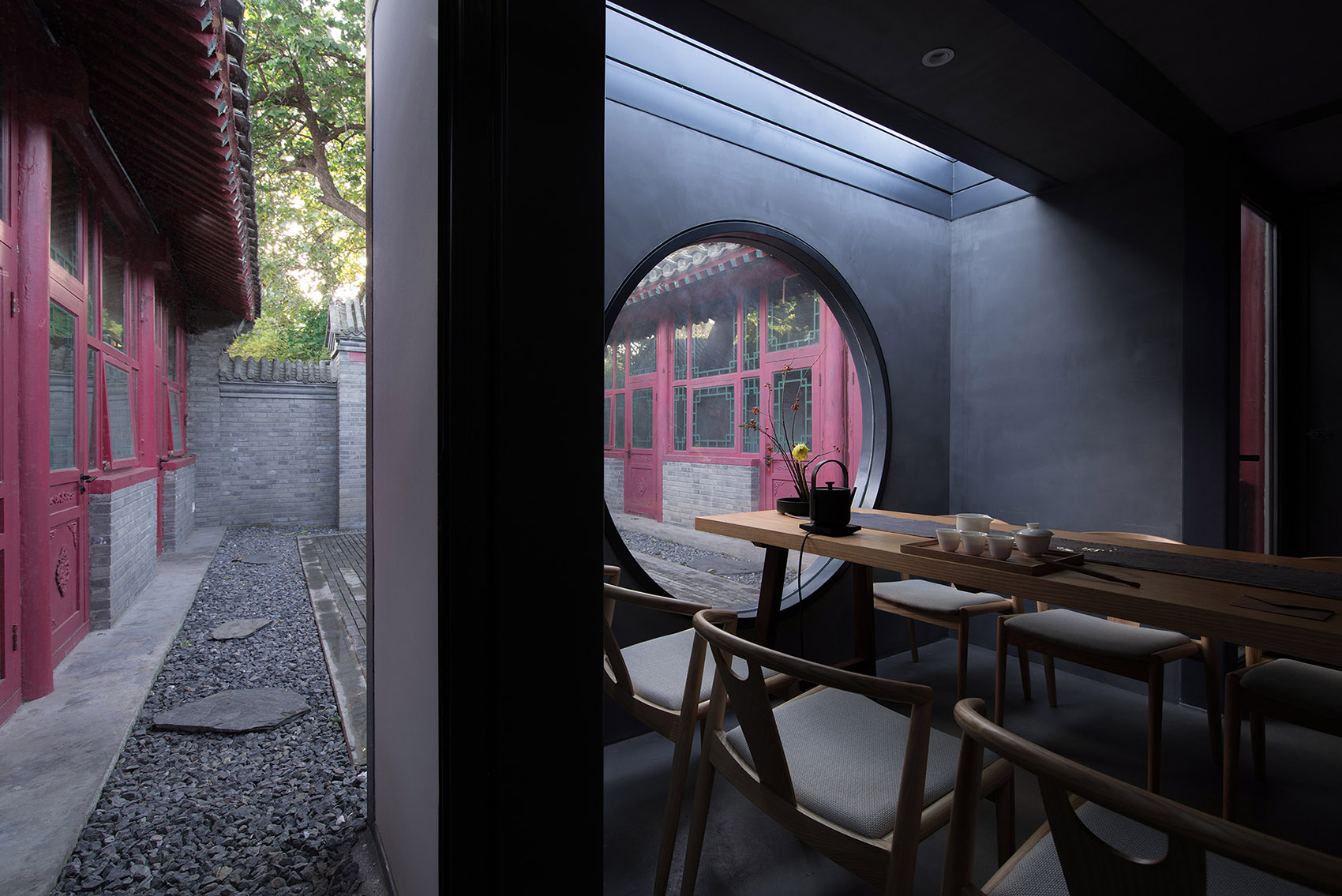
▼在茶室中悠然沏茶,Make tea in the tea house ©陈培新
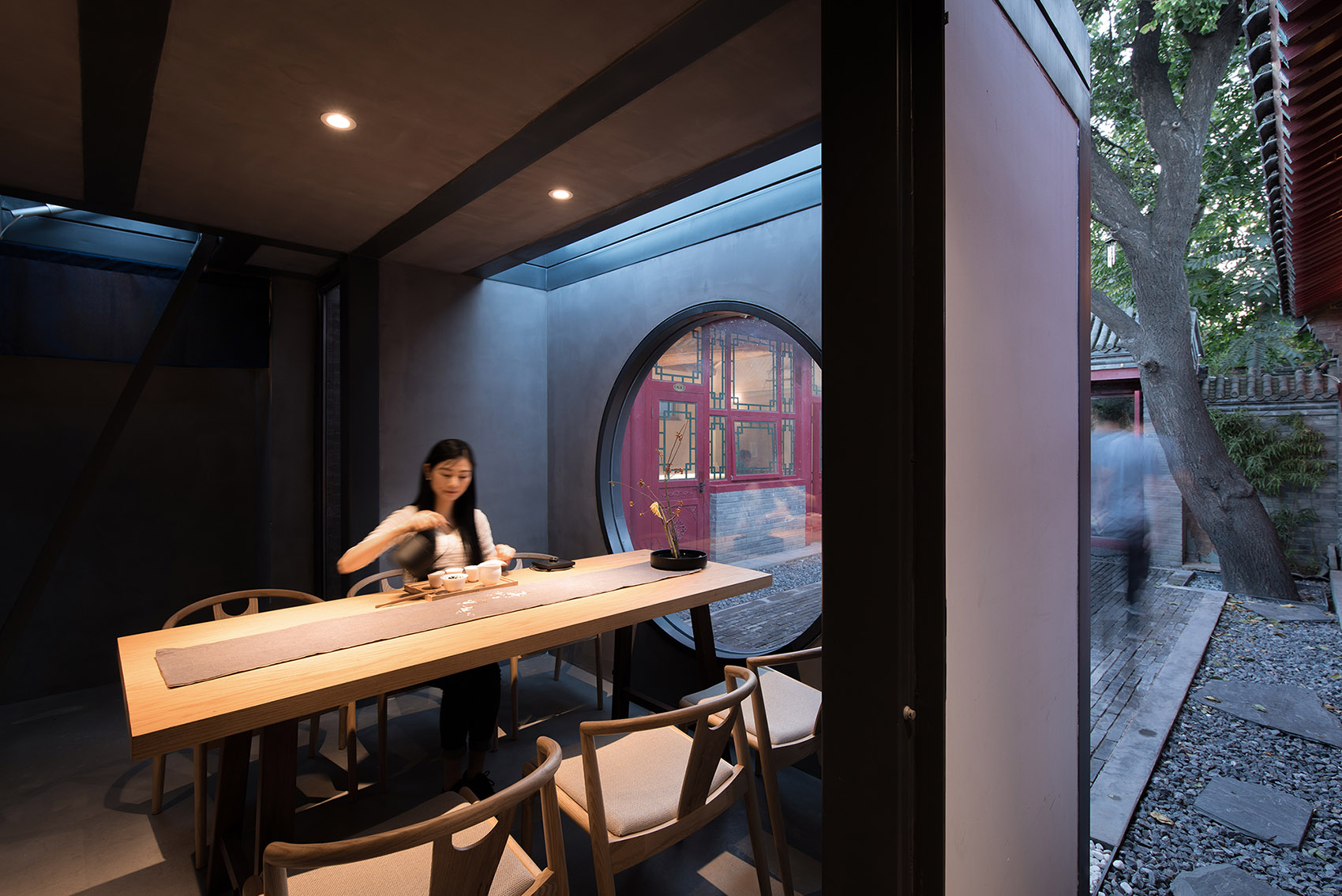
▼长方形天窗与圆窗,Rectangular skylight and round window ©陈培新
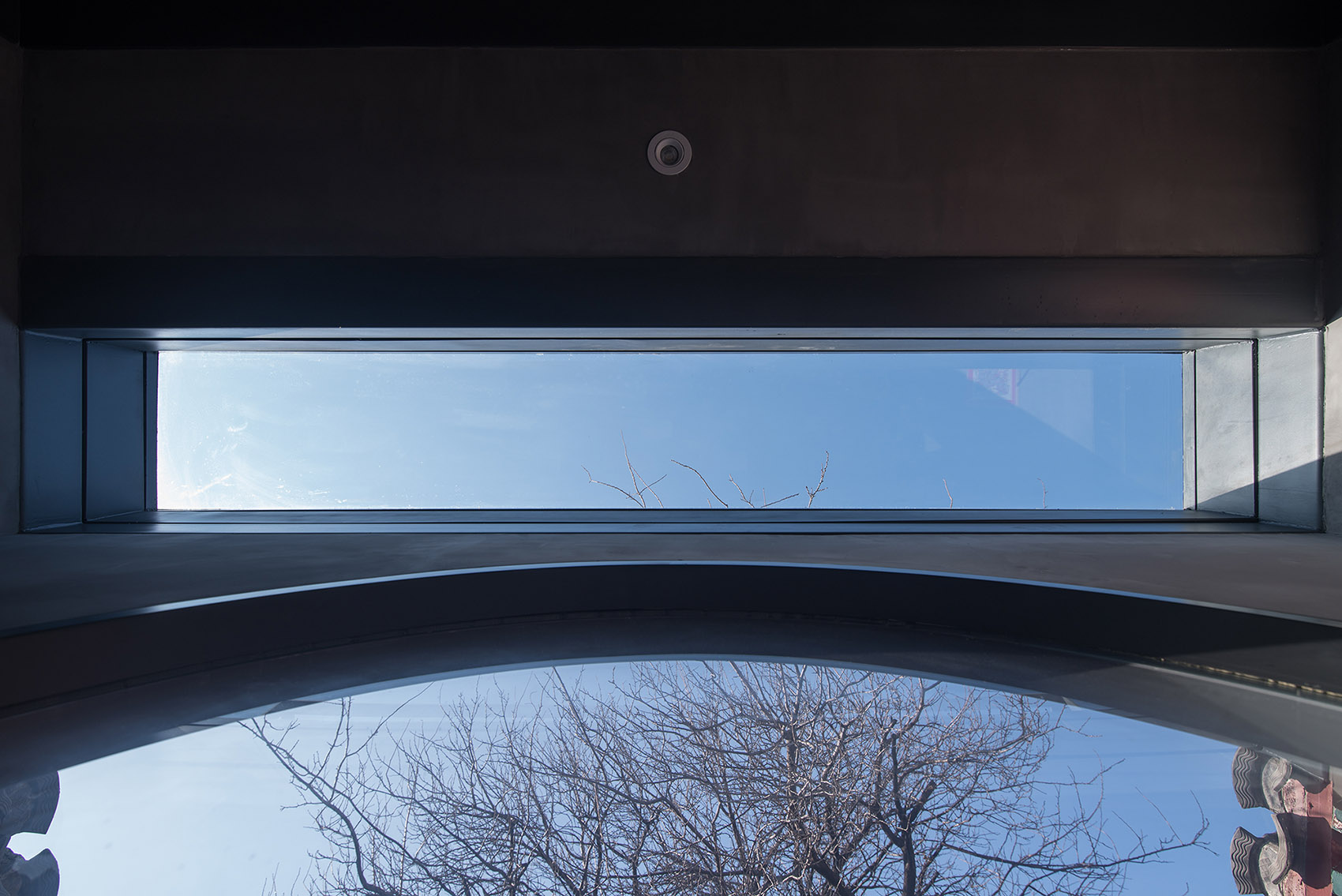
▼透过天窗看杏树,Apricot trees seen through skylights ©陈培新
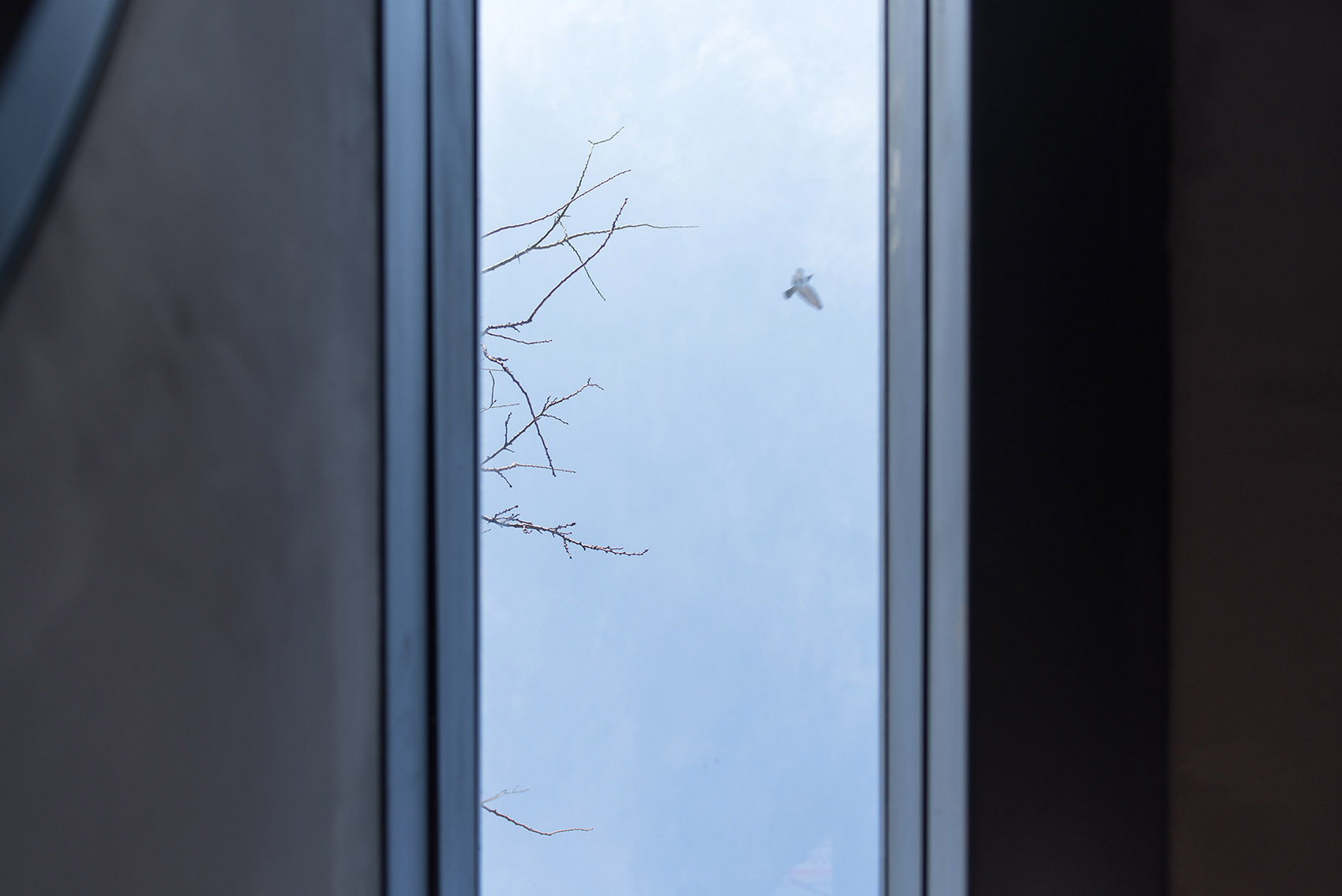
▼茶室爆炸轴测图,Tea house explosion axonometric mapping

新建茶室使用了钢结构,结构构件外露,强调空间中的线条关系,与原建筑的木结构相呼应。露台栏杆被缩小了高度,让饮茶者入座后,隐匿于山墙之下,融于环境之中。双层茶空间不仅加深了与杏树的对话,创造了不同的喝茶体验,还可在露台上远眺钟鼓楼,在空间上又一次与城市产生连接。
The steel structure is used for the new tea house. With the structural members exposed, it emphasizes the relationship of the lines in the space and echoes the wooden structure of the original building. The terrace railing is reduced in height to allow the tea drinkers to get themselves hidden inside the gables and involved in the environment. The double-layer space of the tea house not only deepens the communication between man and the apricot tree so as to create different experience about tea drinking, but also connects with the city once again by overlooking the Bell and Drum tower from the terrace.
▼天窗,The skylight ©陈培新

▼露台,The terrace ©陈培新
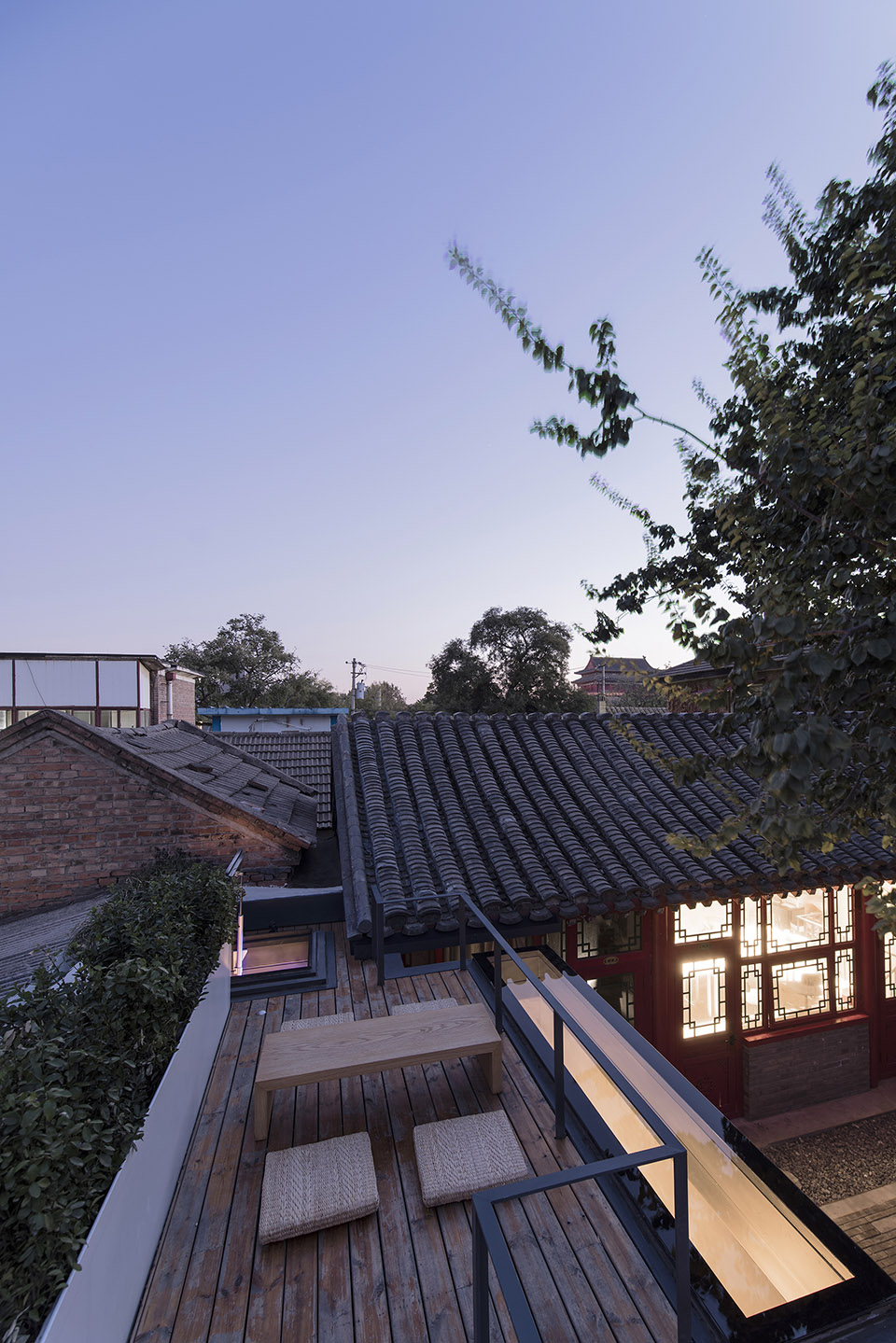
▼远眺钟鼓楼,Overlooking the bell and drum tower ©陈培新

庭院青砖立砌,沿东西向排布,内部错落嵌入条形混凝土,线性的节奏让狭小的庭院稍显舒展。青砖与青石延续了新加的灰色调元素,只留出茶室正面的白墙,以接收杏树的光影。南北房内部屋顶保留了原有的材质,新旧之间通过槽铝分割开来,一条延续的线条分出上下、新旧的质感。
The courtyard is built of black bricks and arranged along the east-west direction. With the strips of concrete embedded between the black bricks, the horizontal pattern widens the width of the narrow courtyard. The black bricks and black stones correspond with the overall gray tone, leaving the white front wall of the tea house alone to receive the light and shadow of the apricot tree. As the interior roof of the north and south houses retains the original material, the new and the old are separated by the aluminum groove, making a continuous line to separate the texture between the upper and lower as well as the new and the old.
▼新旧之间,Between the old and new ©陈培新

整个项目中,建筑师参与到建筑前期策划,通过微介入的方式使四合院空间适应新的使用需求。新与旧的对话是对建筑现状的尊重,以此延续城市的良性更新;新加茶室在四合院中探讨人与自然的关系,这是对传统精神的回应,也是对当下生活的反思。
In the whole project, the architect participated in the early planning of the renovation, and made the space of the courtyard adapt to the new needs by the means of micro-intervention. The dialogue between the new and the old is the respect for architecture as it is thus to continue the benign metabolism of the city; the new tea house explores the relationship between man and nature in the courtyard, which is a response to the traditional values as well as a reflection on the present life.
▼茶室夜景,The tea house at night ©金伟琦
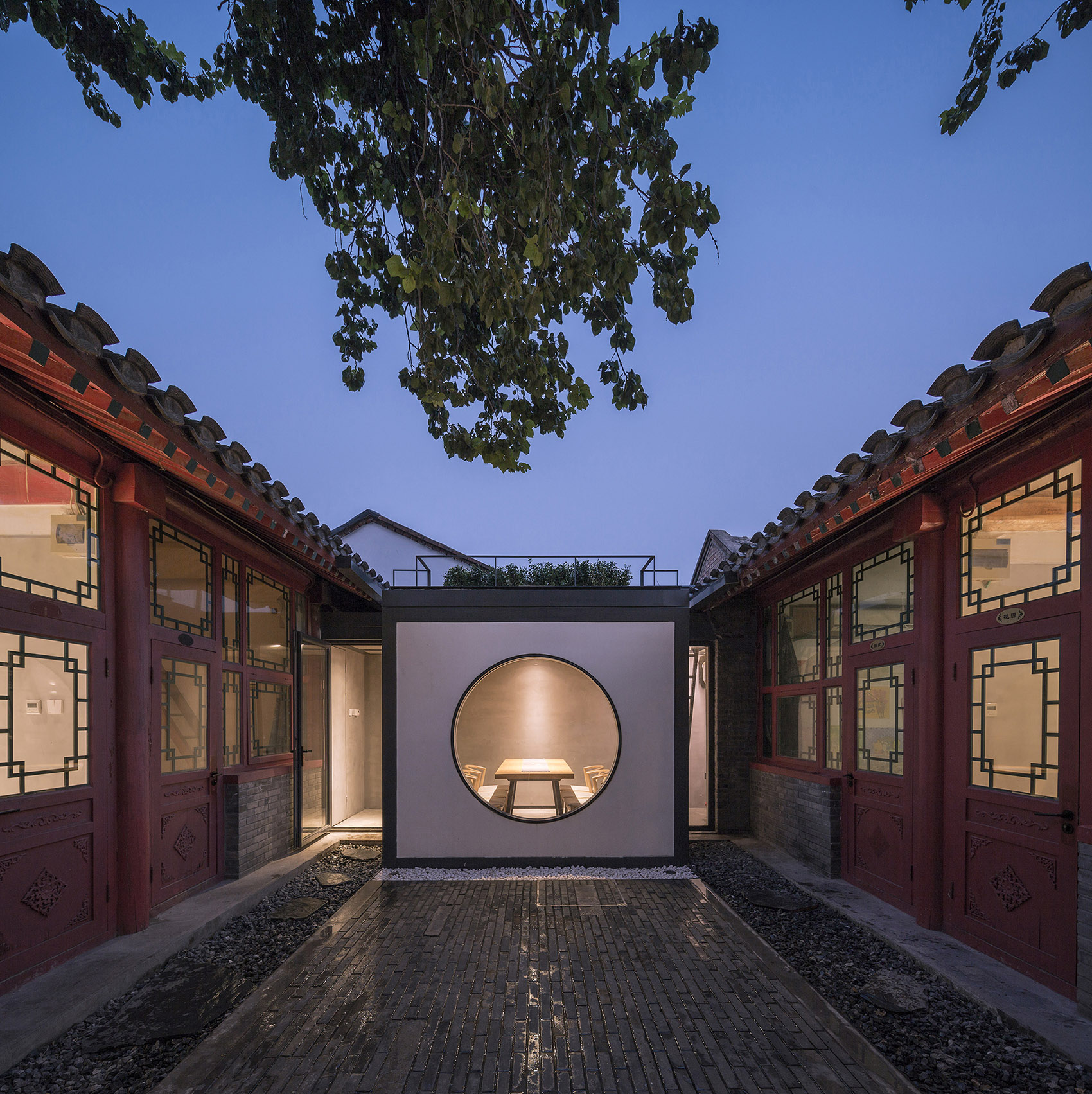
▼一层平面图,Ground floor plan

▼屋顶平面图,Roof plan
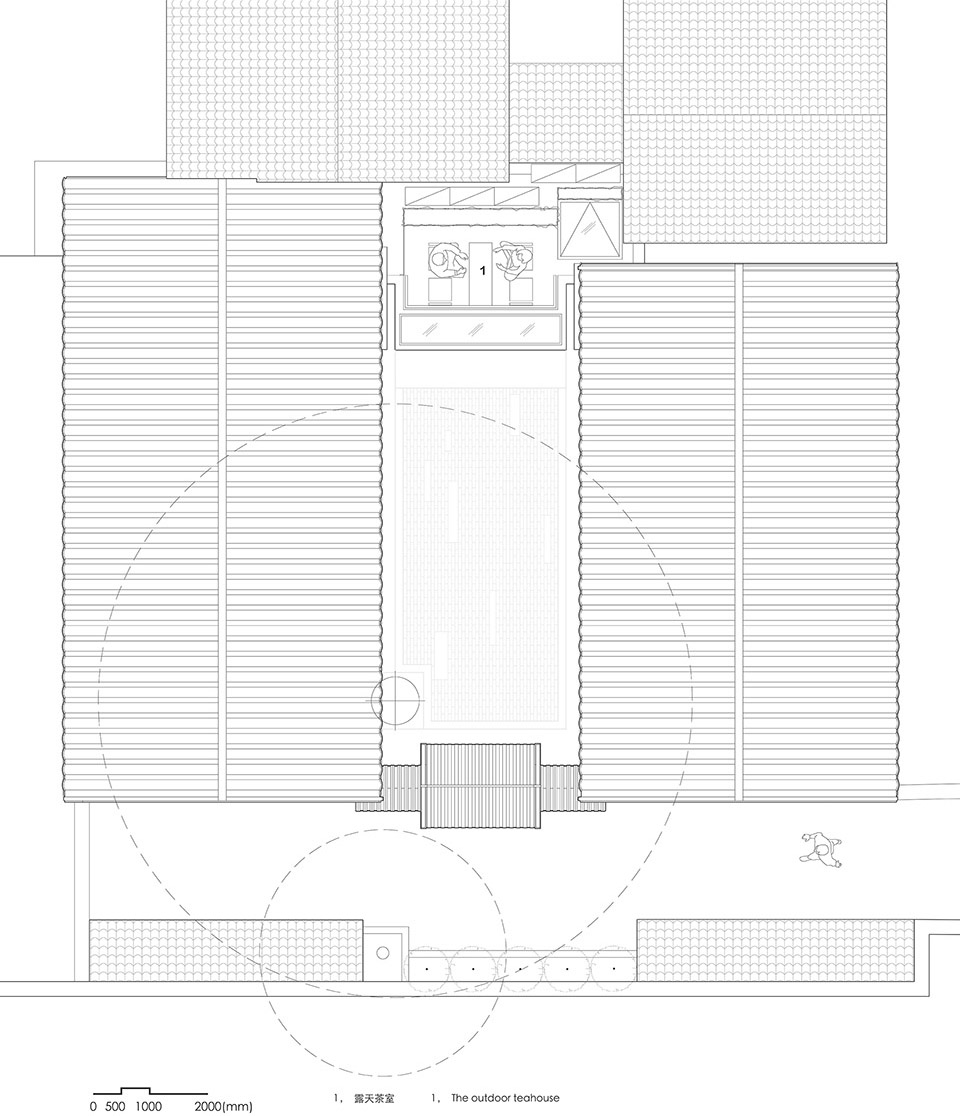
▼剖透视图 , Section view
